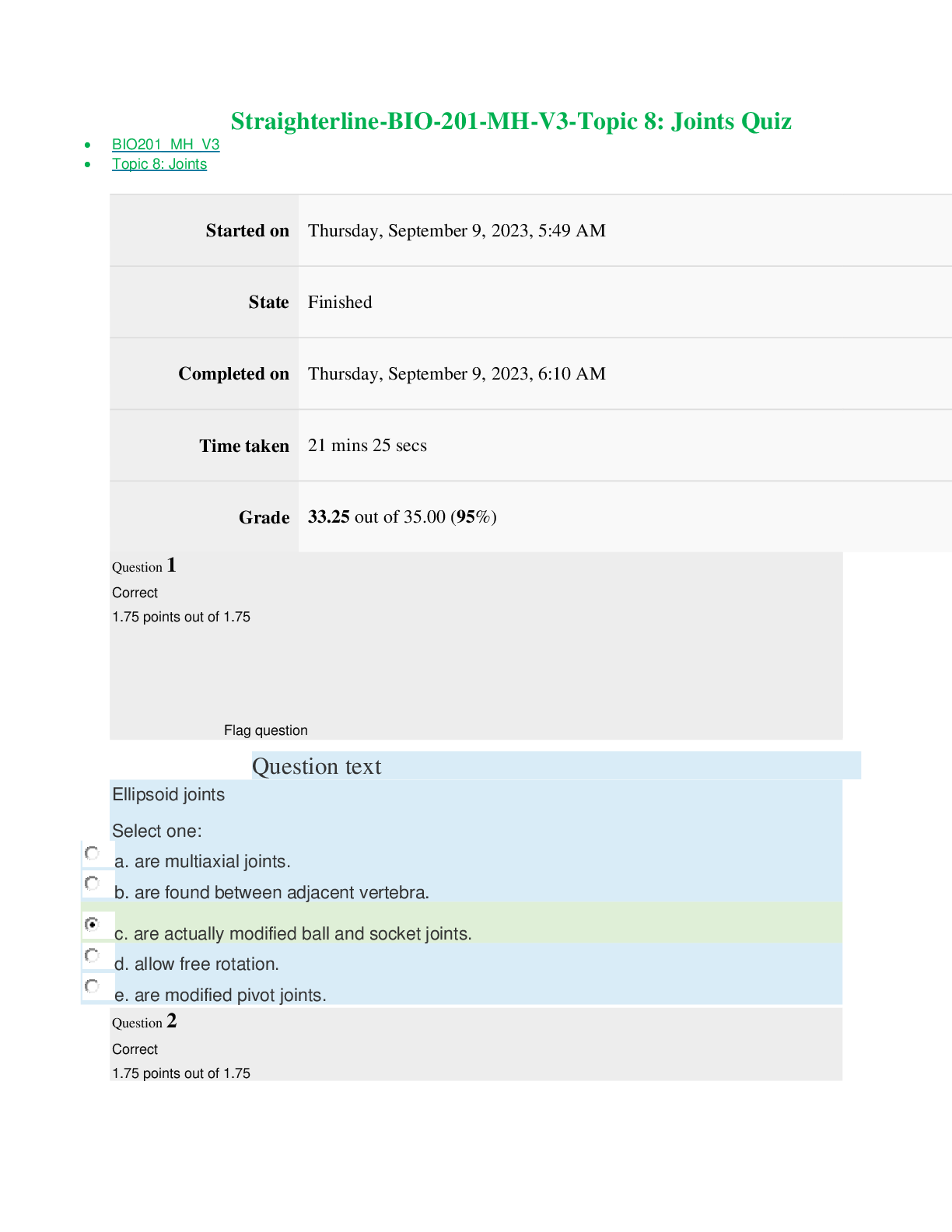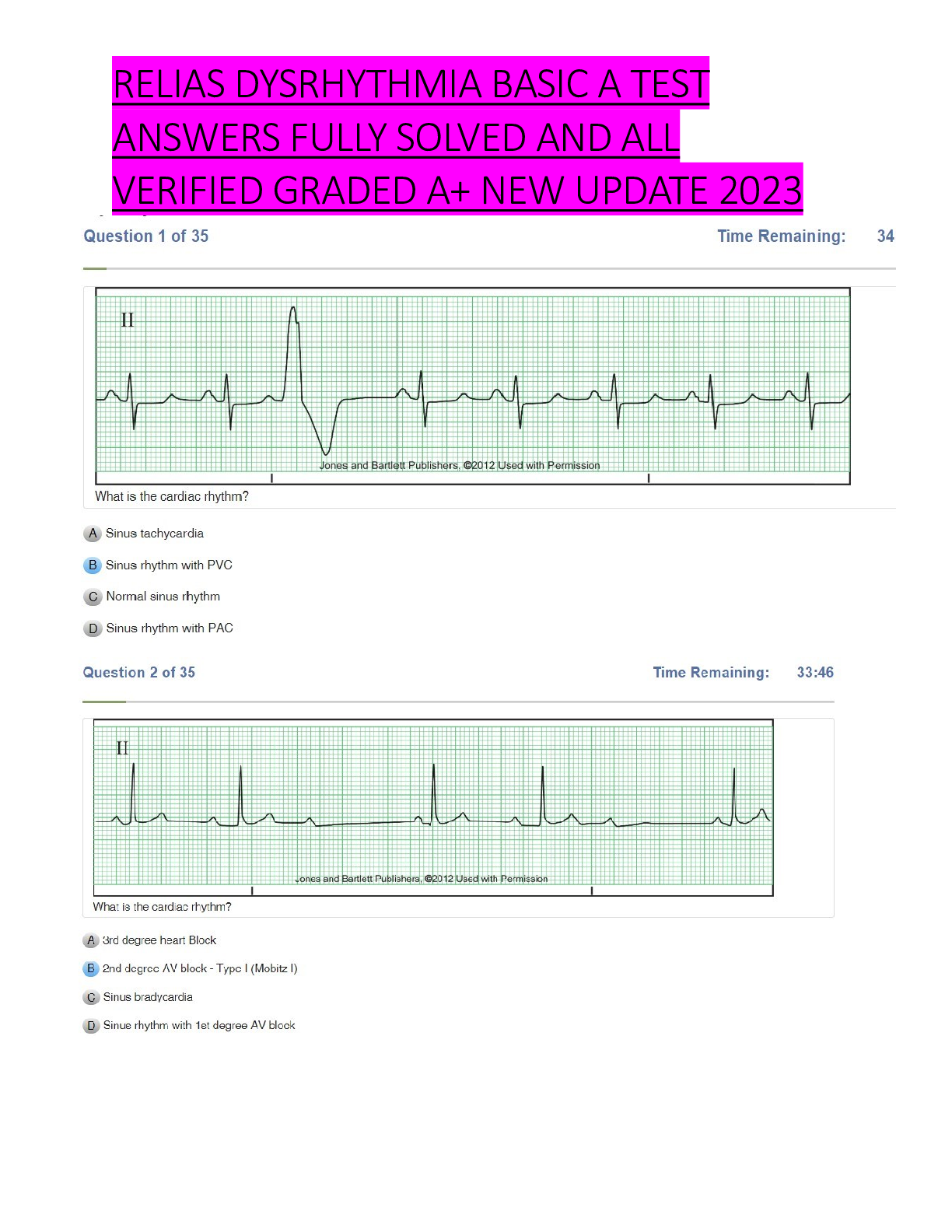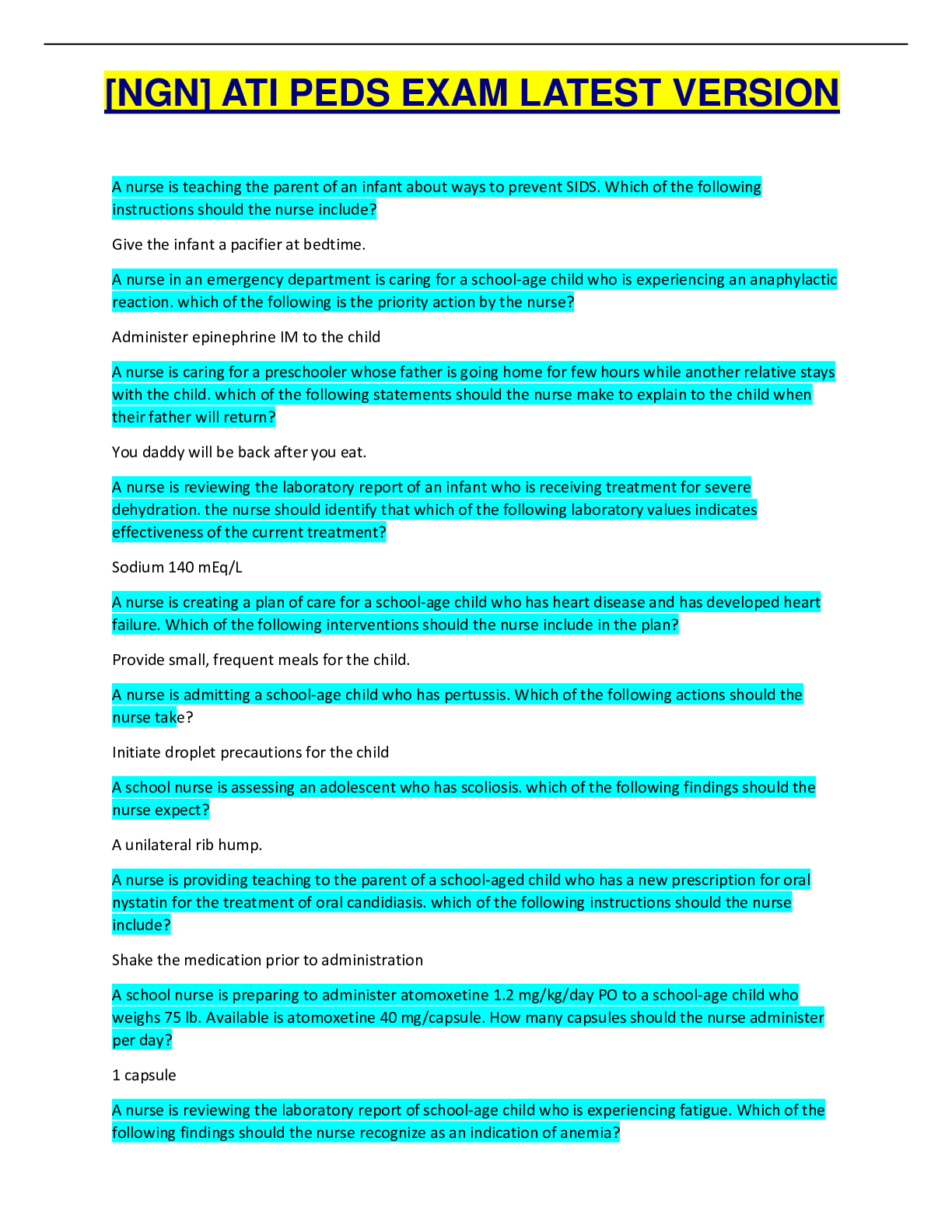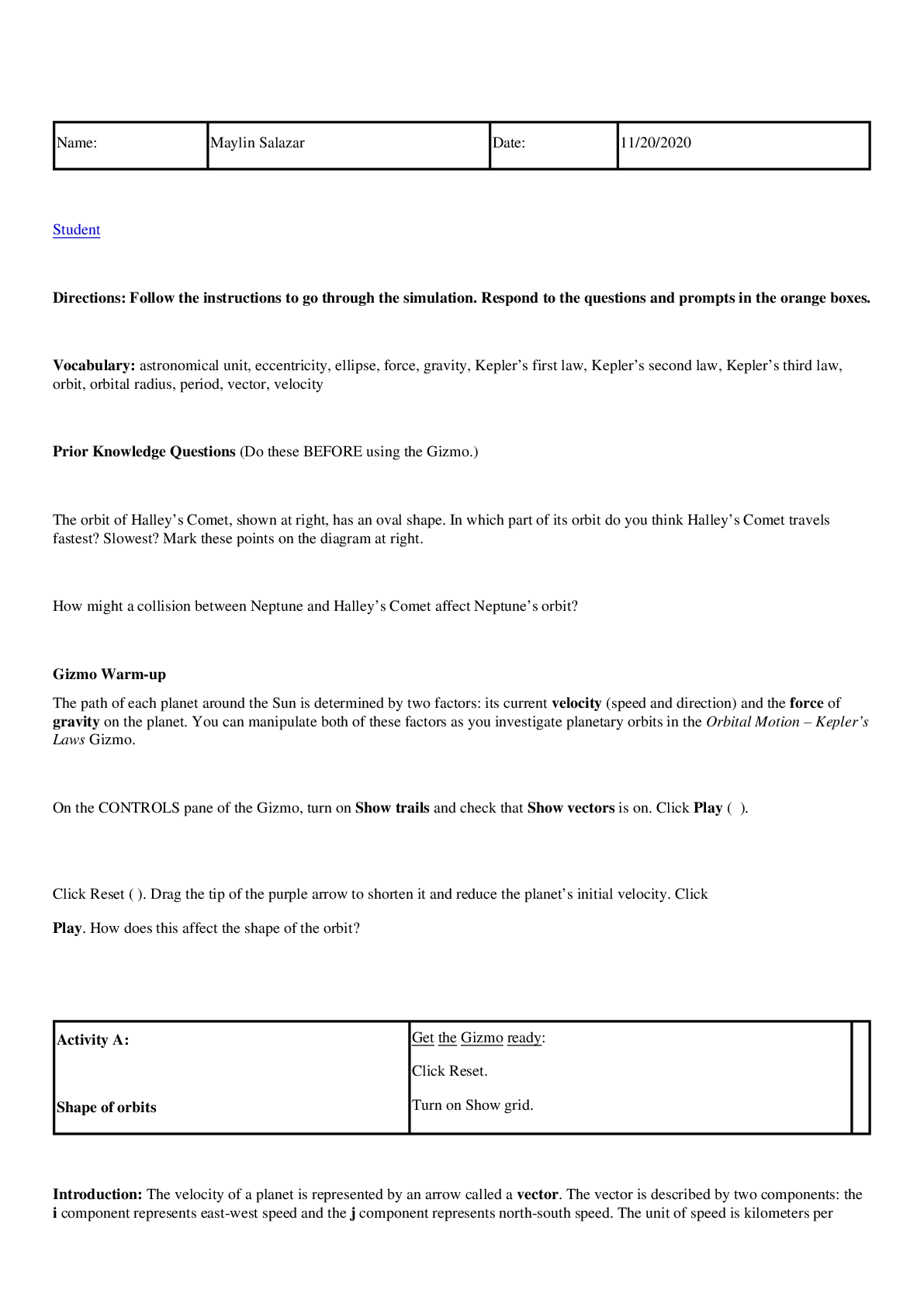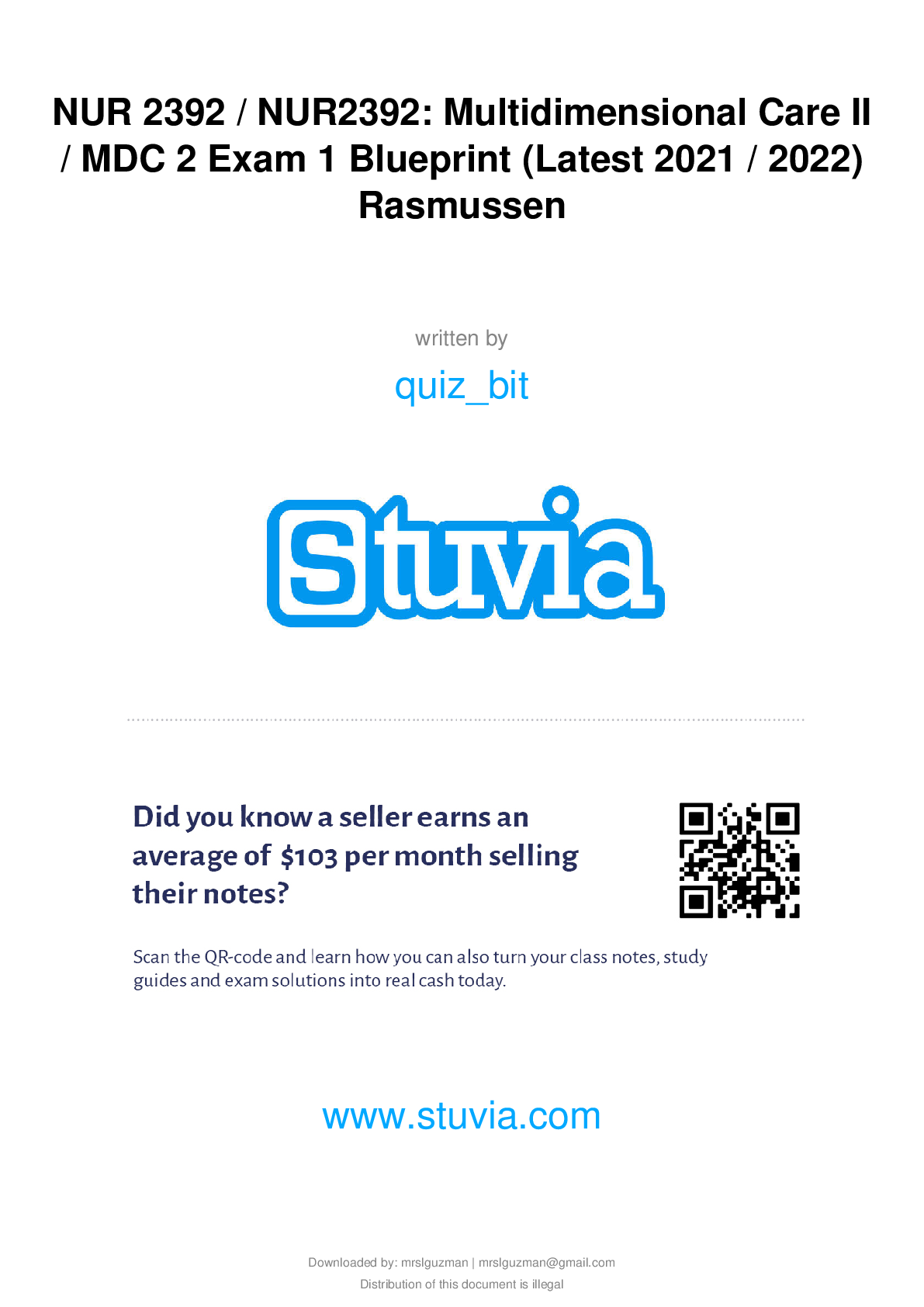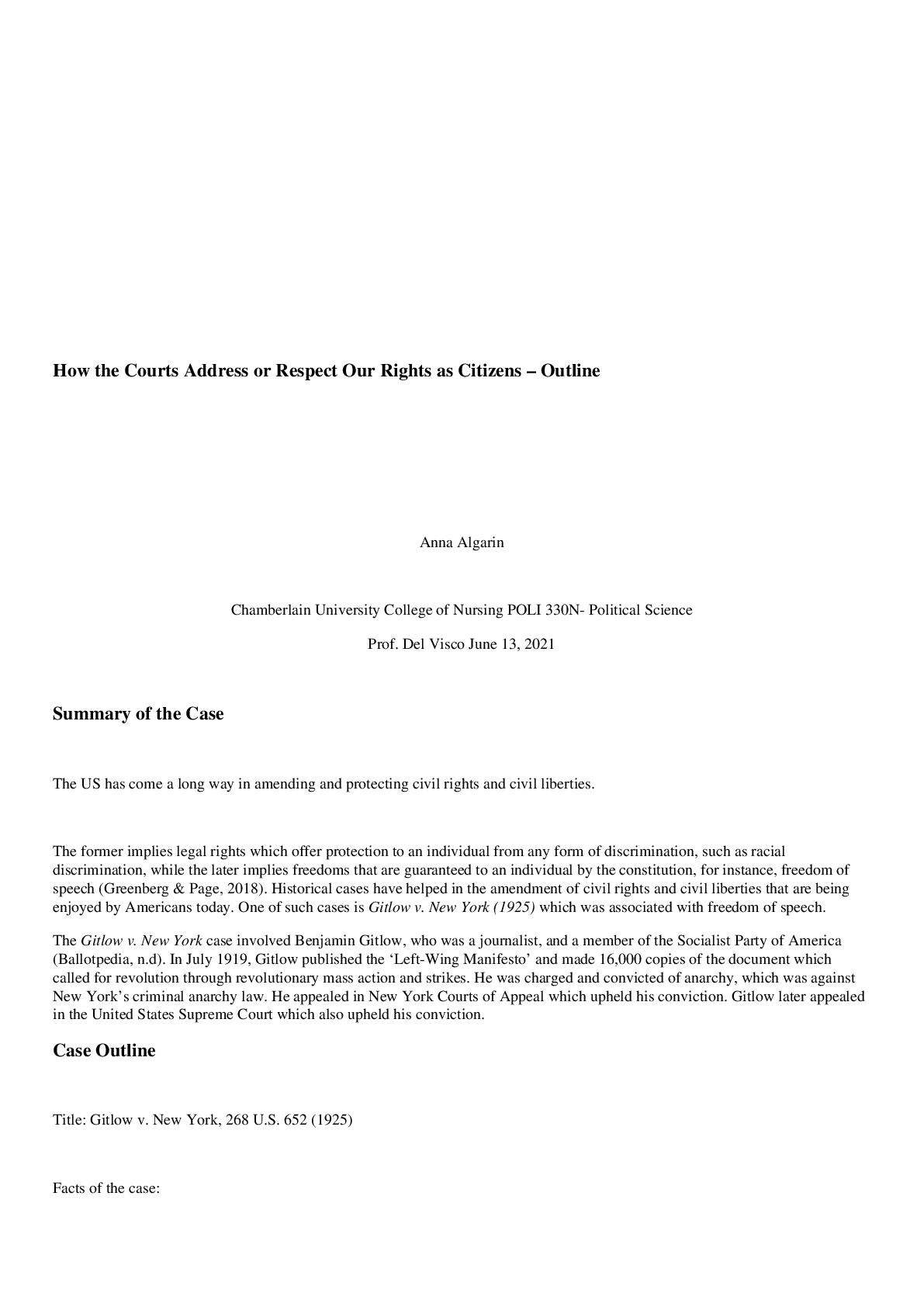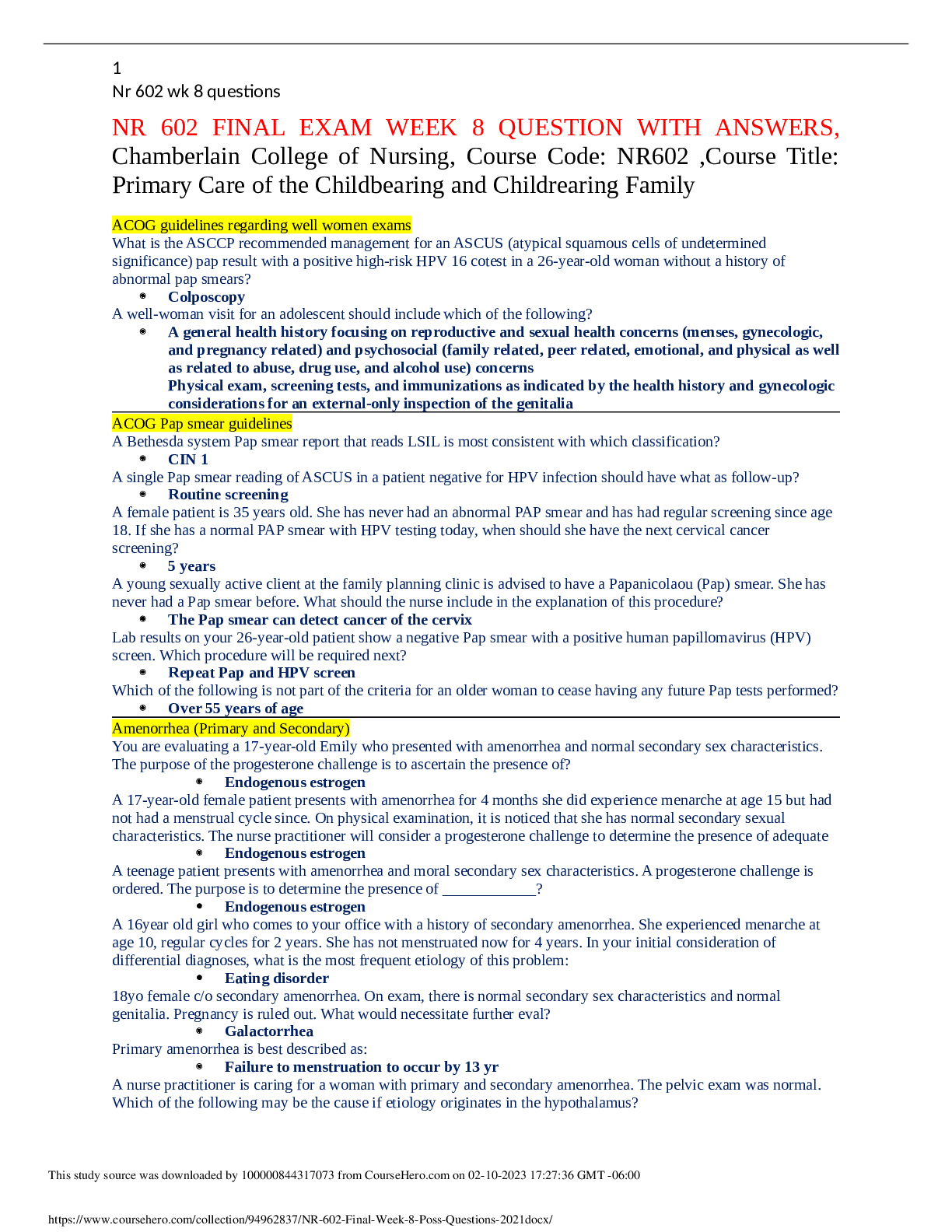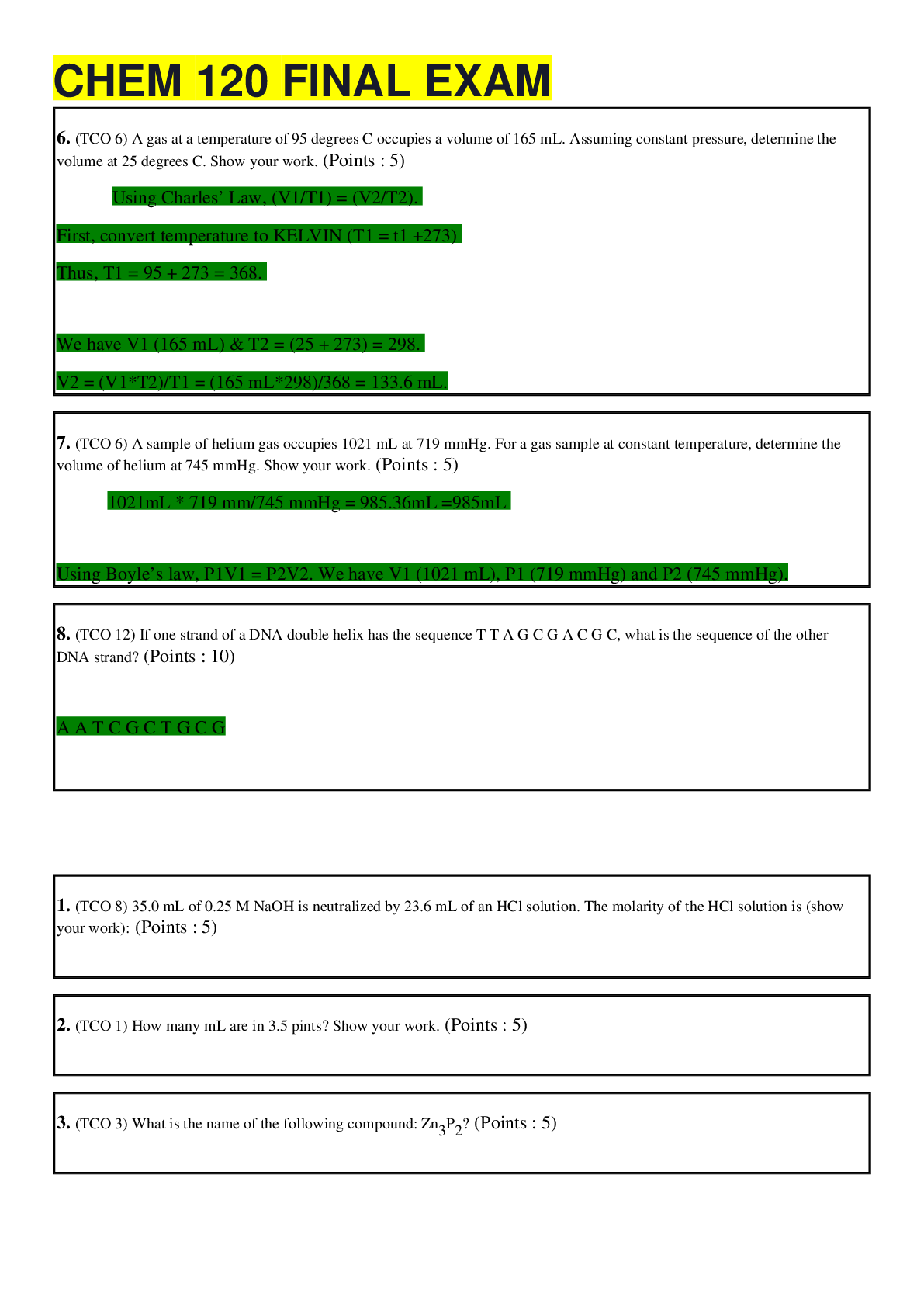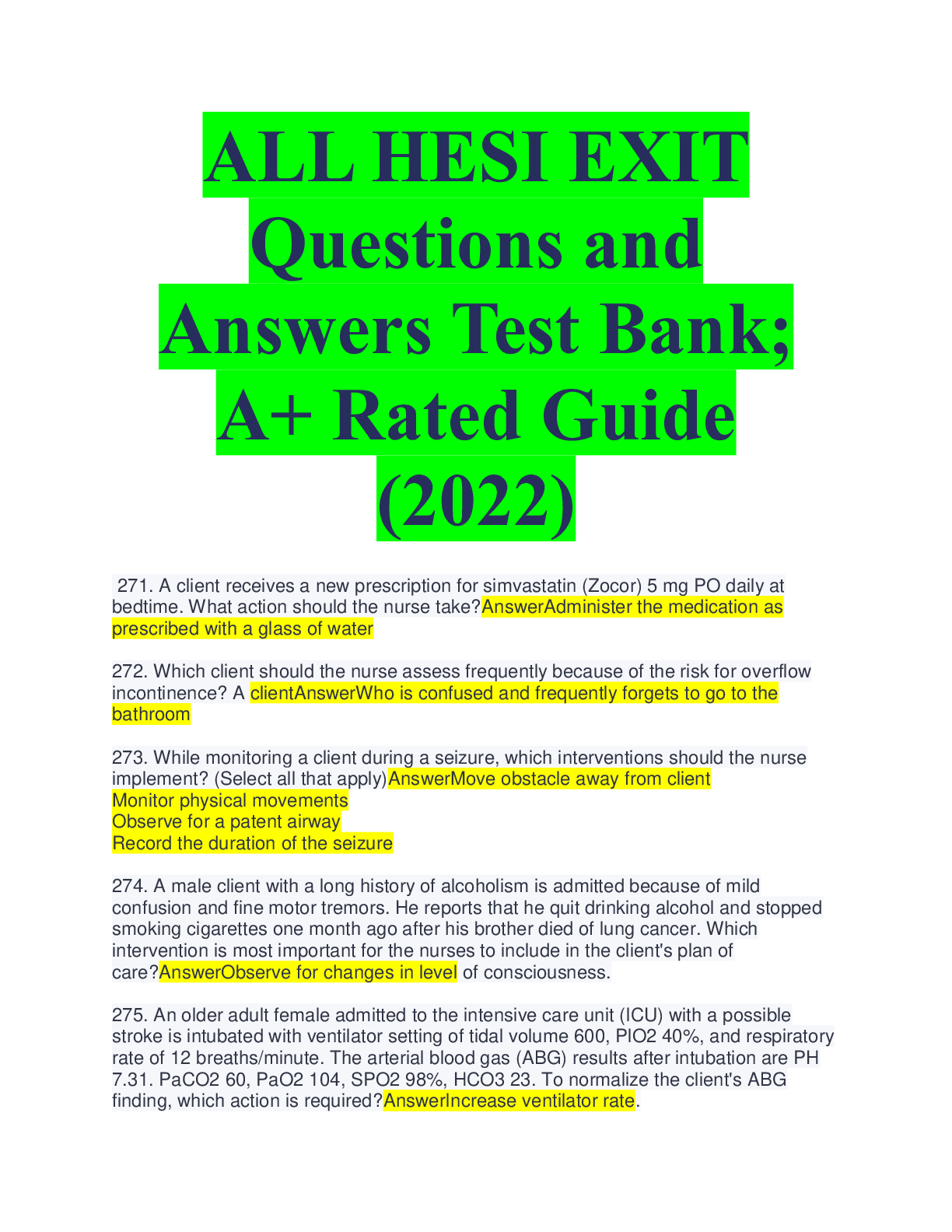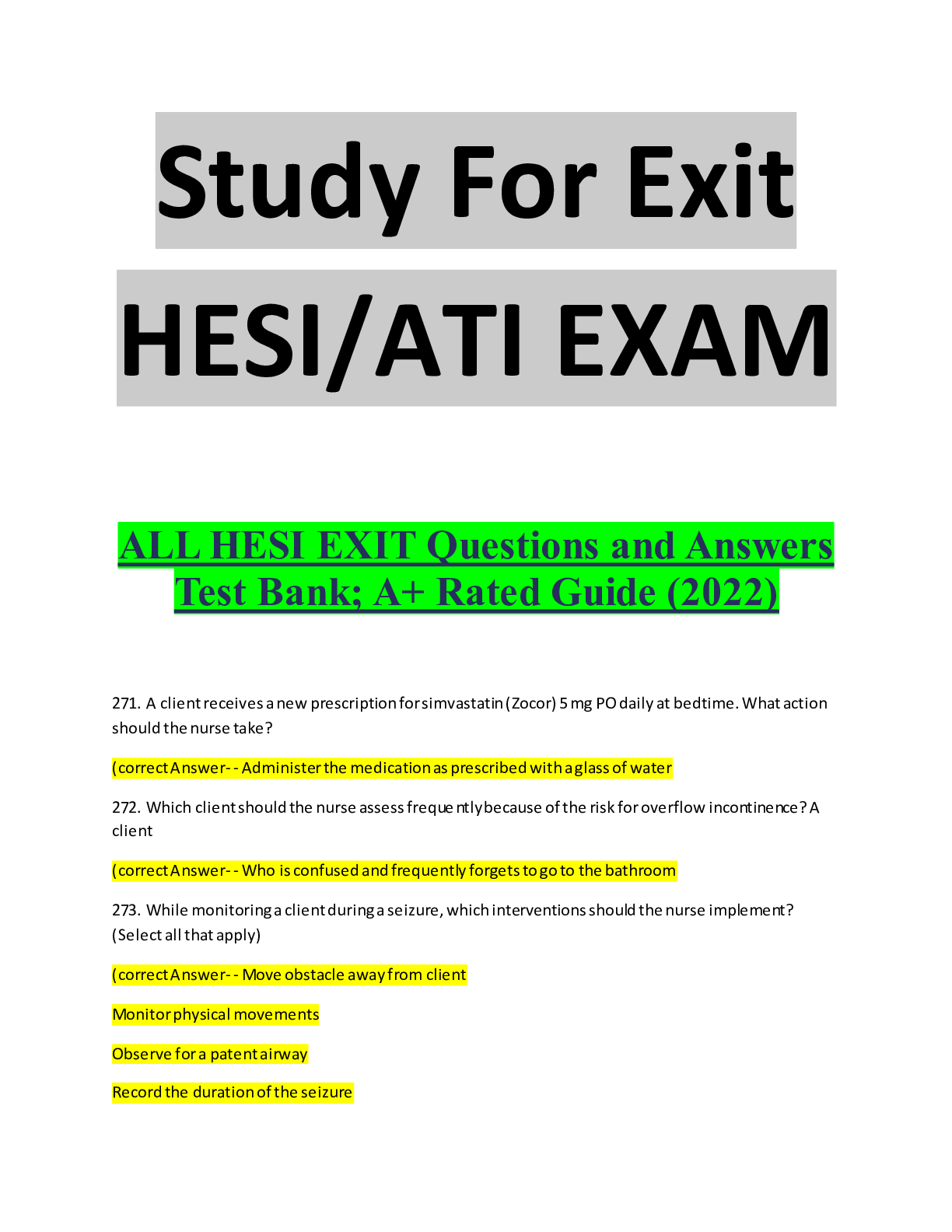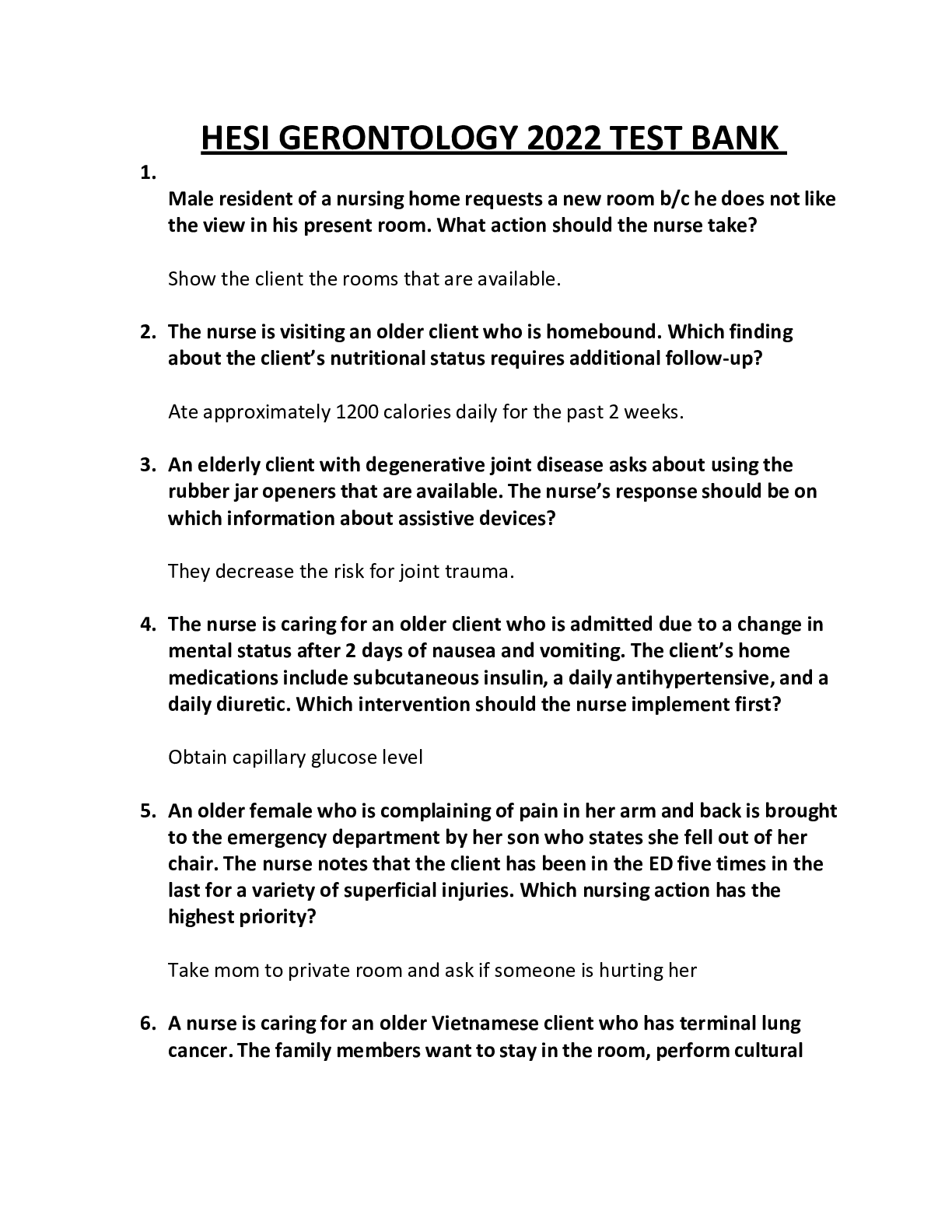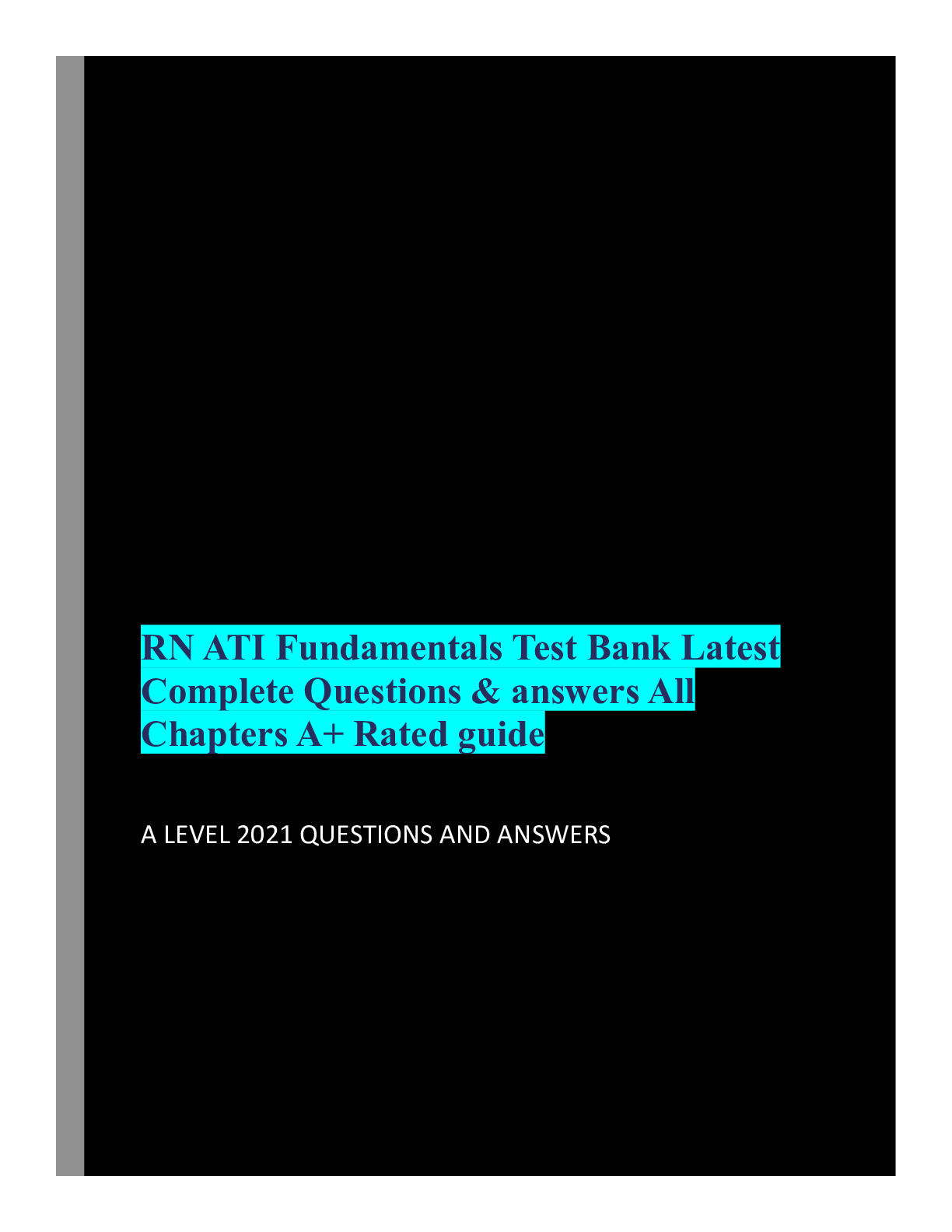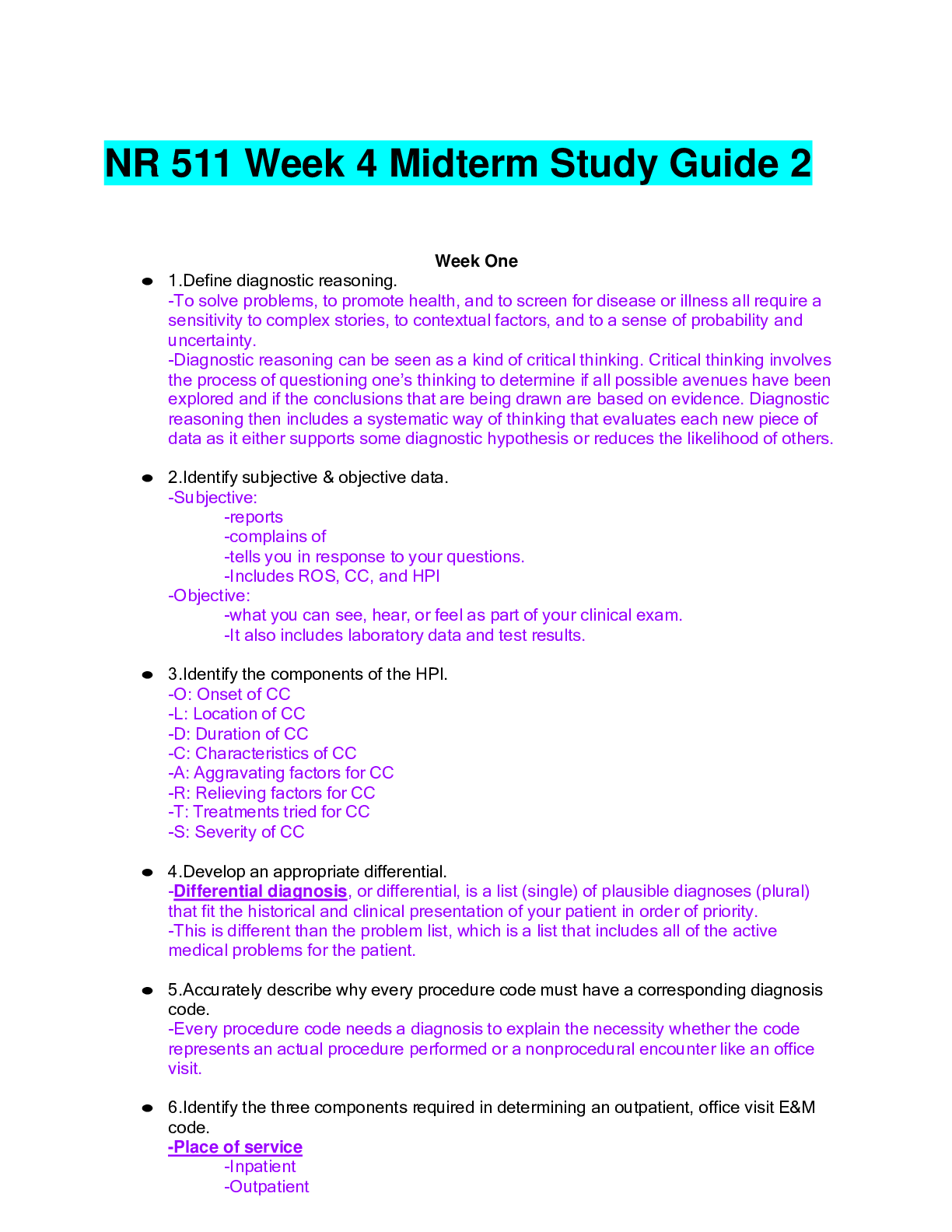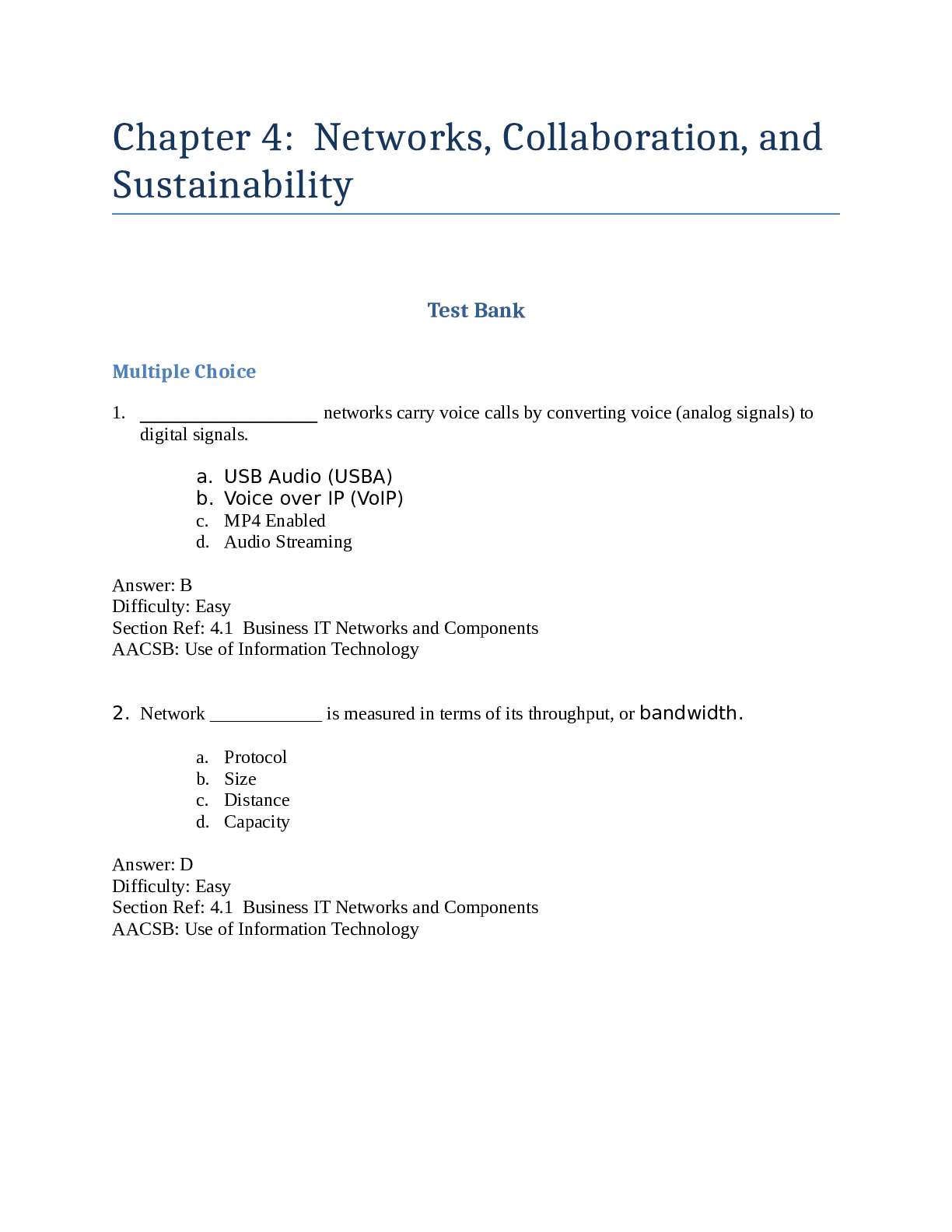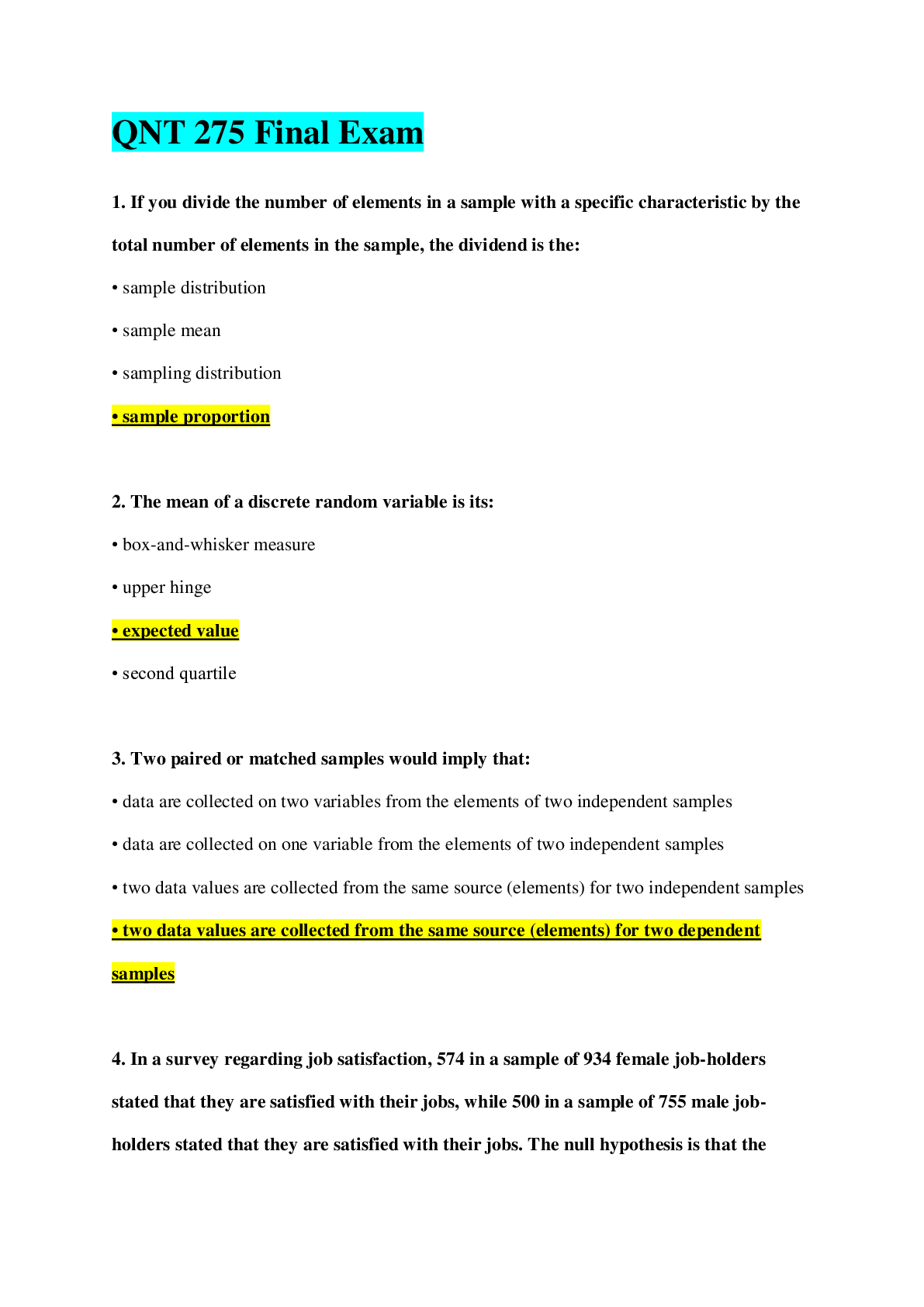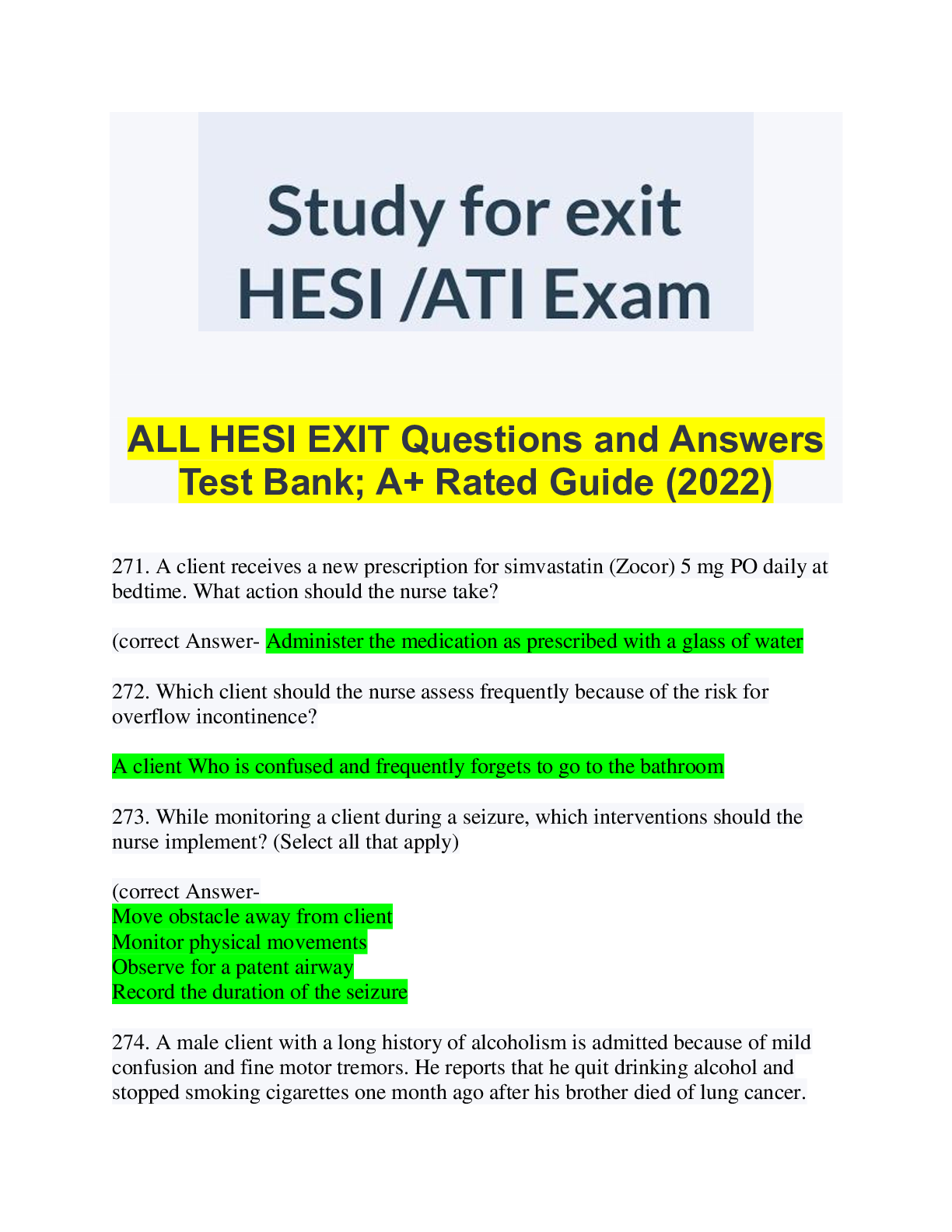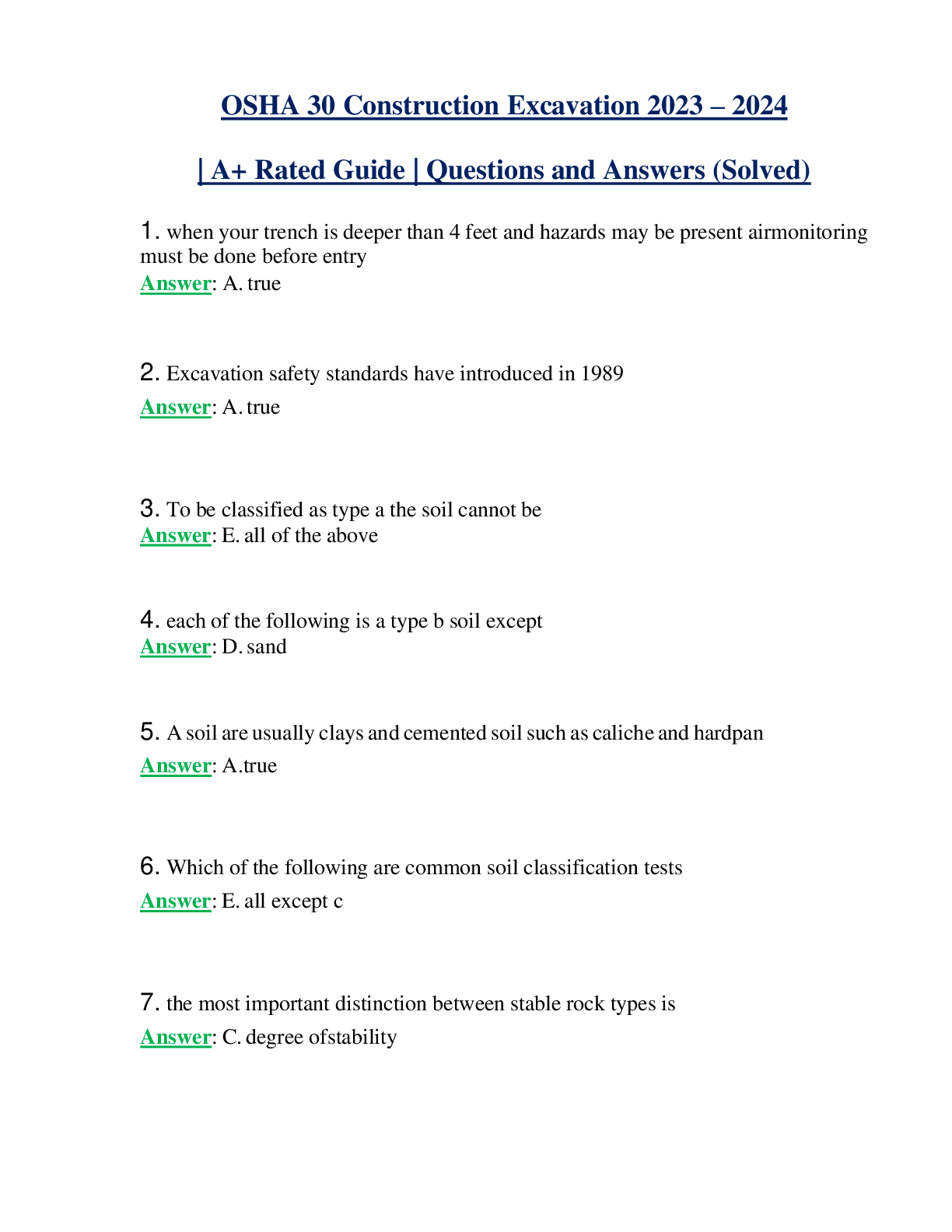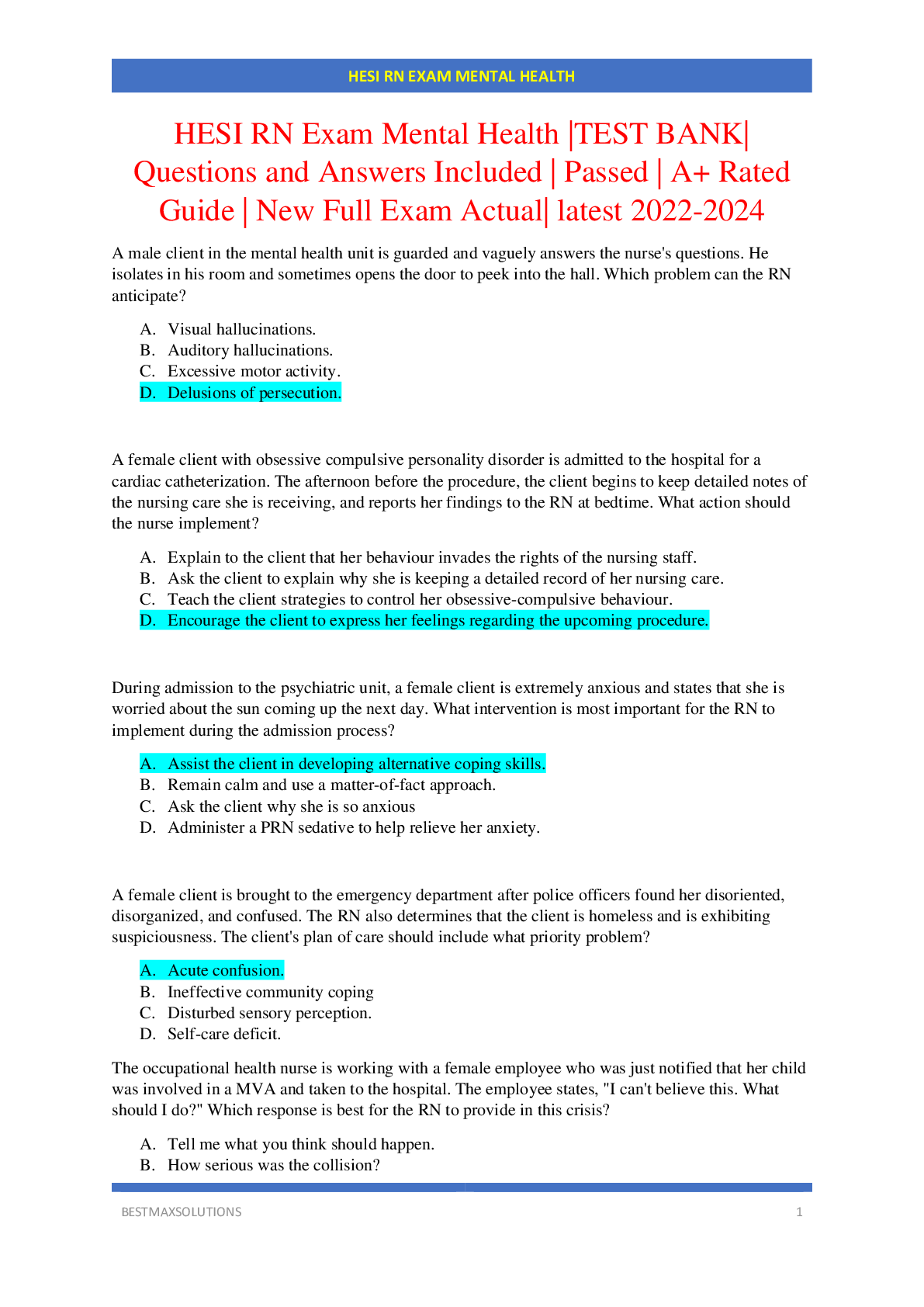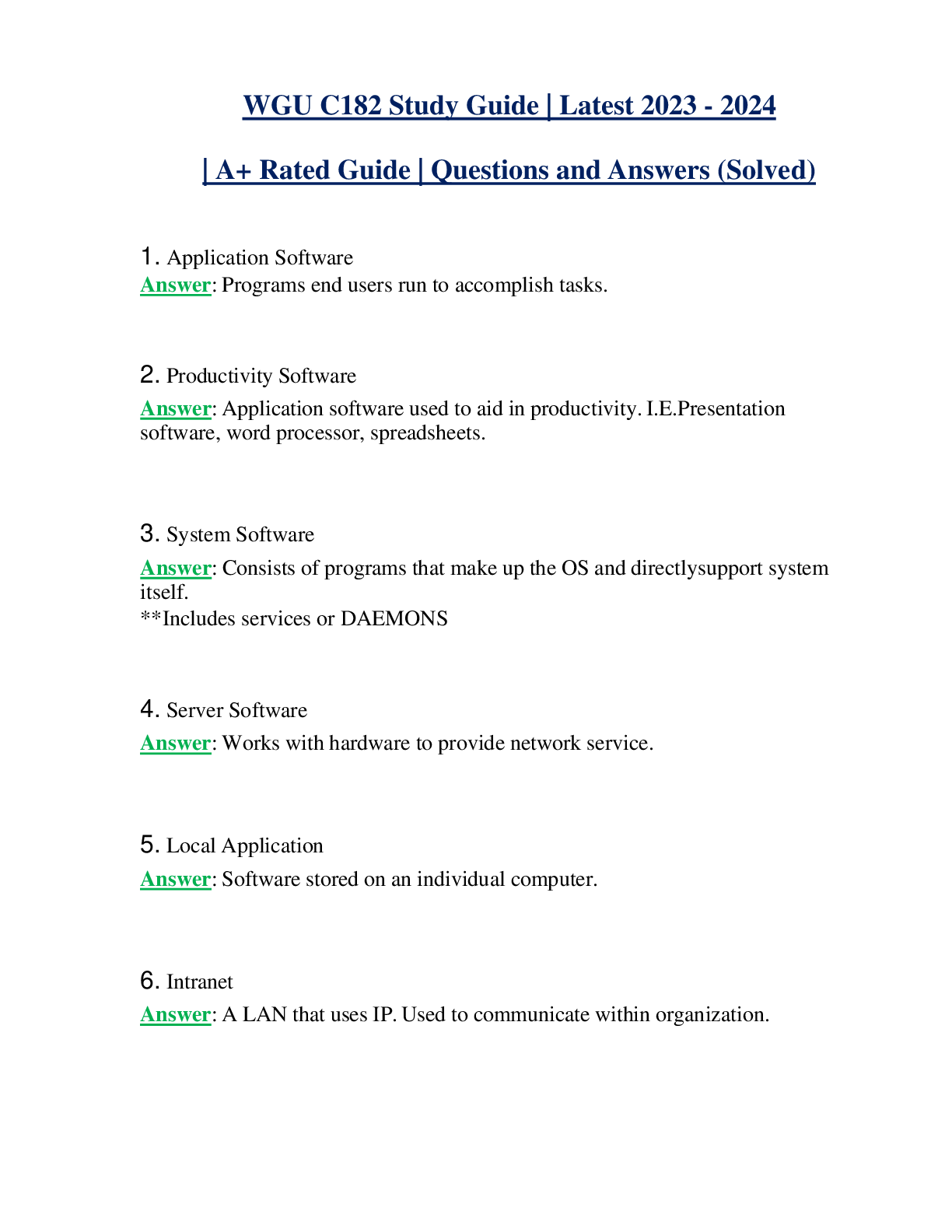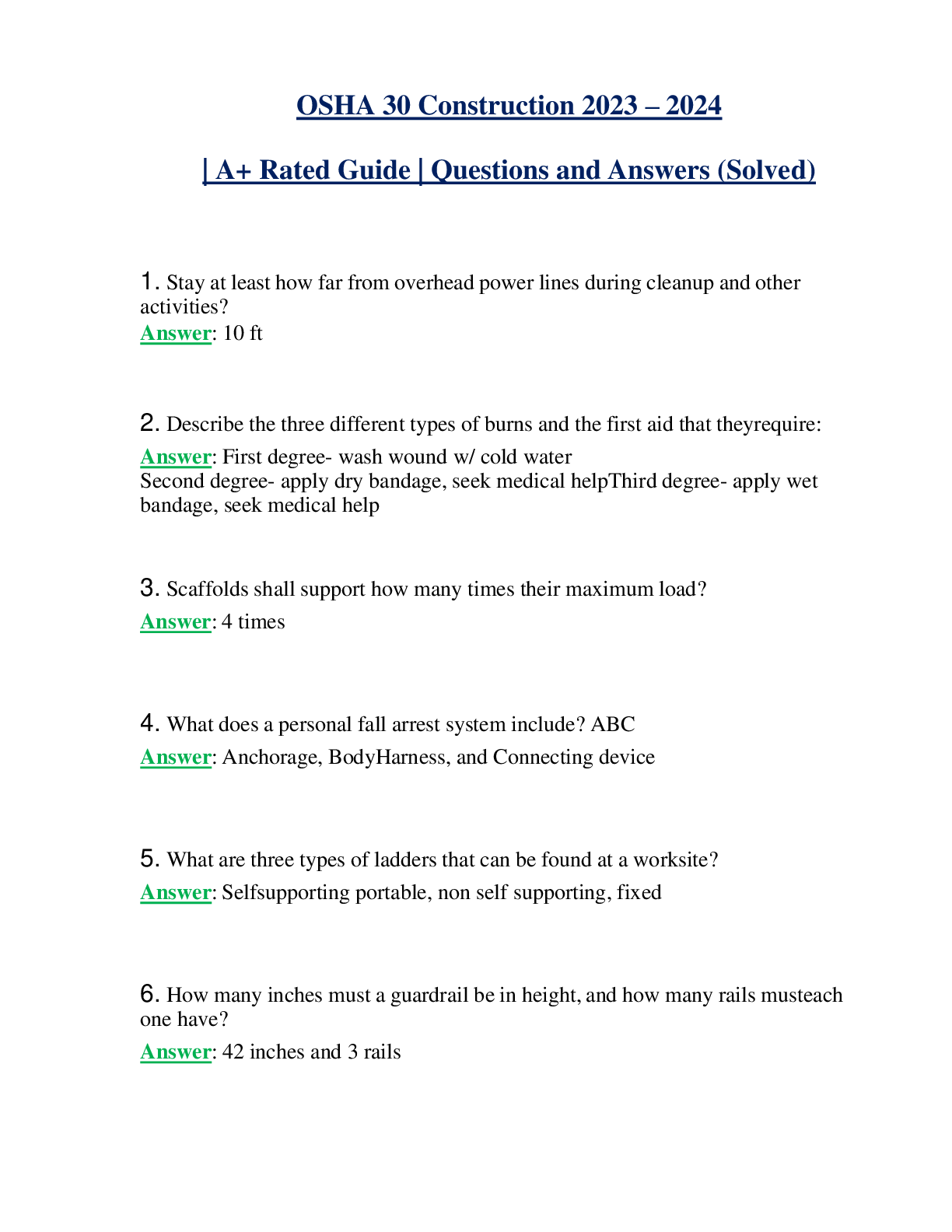*NURSING > EXAM > RN ATI Fundamentals Test Bank, Latest Complete Questions & answers;All Chapters, A+ Rated guide . (All)
RN ATI Fundamentals Test Bank, Latest Complete Questions & answers;All Chapters, A+ Rated guide .
Document Content and Description Below
1 | P a g e RN ATI Fundamentals (10.0) Chapter 1 1. A nurse is discussing restorative health care with a newly licensed nurse. Which of the following examples should the nurse include in the teaching?... (Select all that apply.) a. Home health care b. Rehabilitation facilities c. Diagnostic centers d. Skilled nursing facilities e. Oncology centers 2. A nurse is explaining the various types of health care coverage clients might have to a group of nurses. Which of the following health care financing mechanisms should the nurse include as federally funded? (Select all that apply.) a. Preferred provider organization (PPO) b. Medicare c. Long-term care insurance d. Exclusive provider organization (EPO) e. Medicaid 3. A nurse manager is developing strategies to care for the increasing number of clients who have obesity. Which of the following actions should the nurse include as a primary health care strategy? a. Collaborating with providers to perform obesity screenings during routine office visits. b. Ensuring the availability of specialized beds in rehabilitation centers for clients who have obesity. c. Providing specialized intraoperative training in surgical treatments for obesity. d. Educating acute care nurses about postoperative complications related to obesity. 4. A nurse is discussing the purpose of regulatory agencies during a staff meeting. Which of the following tasks should the nurse identify as the responsibility of state licensing boards? a. Monitoring evidence-based practice for clients who have a specific diagnosis. b. Ensuring that health care providers comply with regulations. c. Setting quality standards for accreditation of health care facilities. d. Determining whether medications are safe for administration to clients. 5. A nurse is explaining the various levels of health care services to a group of newly licensed nurses. Which of the following examples of care or care settings should the nurse classify as tertiary care? (Select all that apply.) a. Intensive care unit b. Oncology treatment center c. Burn center Complete_all 58 Chapters_Answered2 | P a g e d. Cardiac rehabilitation e. Home health care Chapter 2 1. A nurse is caring for a group of clients on a medical surgical unit. For which of the following client care needs should the nurse initiate a referral for a social worker? (Select all that apply.) a. A client who has terminal cancer requests hospice care in the home. b. A client asks about community resources available for older adults. c. A client states, “I would like to have my child baptized before surgery.” d. A client requests an electric wheelchair for use after discharge. e. A client states, “I do not understand how to use a nebulizer.” 2. A goal for a client who has difficulty with self-feeding due to rheumatoid arthritis is to use adaptive devices. The nurse caring for the client should initiate a referral to which of the following members of the interprofessional care team? a. Social worker b. Certified nursing assistant c. Registered dietitian d. Occupational therapist 3. A client who is postoperative following knee arthroplasty is concerned about the adverse effects of the medication prescribed for pain managements. Which of the following members of the interprofessional care team can assist the client in understanding the medication’s effects? (Select all that apply.) a. Provider b. Certified nursing assistant c. Pharmacist d. Registered nurse e. Respiratory therapist 4. A client who had a cerebrovascular accident has persistent problems with dysphagia. The nurse caring for the client should initiate a referral with which of the following members of the interprofessional care team? a. Social worker b. Certified nursing assistant c. Occupational therapist d. Speech-language pathologist 5. A nurse is acquainting a group of newly licensed nurses with the roles of the various members of the health care team they will encounter on a medical-surgical unit. When providing examples of the types of tasks CNAs can perform, which of the following client activities should the nurse include? (Select all that apply.) a. Bathing b. Ambulating Complete_all 58 Chapters_Answered3 | P a g e c. Toileting d. Determining pain level e. Measuring vital signs Chapter 3 1. A nurse is caring for a client who decides not to have surgery despite significant blockages of the coronary arteries. The nurse understands that this client’s choice is an example of which of the following ethical principles? a. Fidelity b. Autonomy c. Justice d. Nonmaleficence 2. A nurse offers pain medication to a client who is postoperative prior to ambulation. The nurse understands that this aspect of care delivery is an example of which of the following ethical principles? a. Fidelity b. Autonomy c. Justice d. Beneficence 3. A nurse is instructing a group of newly license nurses about the responsibilities organ donation and procurement involve. When the nurse explains that all clients waiting for a kidney transplant have to meet the same qualifications, the newly licensed nurses should understand that this aspect of care delivery is an example of which of the following ethical principles? a. Fidelity b. Autonomy c. Justice d. Nonmaleficence 4. A nurse questions a medication prescription as too extreme in light of the client’s advanced age and unstable status. The nurse understands that this action is an example of which of the following ethical principles? a. Fidelity b. Autonomy c. Justice d. Nonmaleficence 5. A nurse is instructing a group of newly licensed nurses how to know and what to expect when ethical dilemmas arise. Which of the following situations should the newly licensed nurses identify as an ethical dilemma? a. A nurse on a medical-surgical unit demonstrates signs of chemical impairment. b. A nurse overhears another nurse telling an older adult client that if he doesn’t stay in bed, she will have to apply restraints. Complete_all 58 Chapters_Answered4 | P a g e c. A family has conflicting feelings about the initiation of enteral tube feedings for their father, who is terminally ill. d. A client who is terminally ill hesitates to name their partner on their durable power of attorney form. Chapter 4 1. A nurse observes an assistive personnel (AP) reprimanding a client for not using the urinal properly. The AP tells the client that diapers will be used next time the urinal is used improperly. Which of the following torts is the AP committing? a. Assault b. Battery c. False imprisonment d. Invasion of privacy 2. A nurse is caring for a competent adult client who tells the nurse, “I am leaving the hospital this morning whether the doctor discharges me or not.” The nurse believes that this is not in the client’s best interest, and prepares to administer a PRN sedative medication the client has not requested along with the scheduled morning medication. Which of the following types of tort is the nurse about to commit? a. Assault b. False imprisonment c. Negligence d. Breach of confidentiality 3. A nurse in a surgeon’s office is providing preoperative teaching for a client who is scheduled for surgery the following week. The client tells the nurse that “I plan to prepare my advance directives before I come to the hospital.” Which of the following statements mad by the client should indicate to the nurse an understanding of advance directives? a. “I’d rather have my brother make decisions for me, but I know it has to be my wife.” b. “I know they won’t go ahead with the surgery unless I prepare these forms.” c. “I plan to write that I don’t want them to keep me on a breathing machine.” d. “I will get my regular doctor to approve my plan before I hand it in at the hospital.” 4. A nurse is caring for a client who is about to undergo an elective surgical procedure. The nurse should take which of the following actions regarding informed consent? (Select all that apply.) a. Make sure the surgeon obtained the client’s consent. b. Witness the client’s signature on the consent form. c. Explain the risks and benefits of the procedure. d. Describe the consequences of choosing not to have the surgery. e. Tell the client about alternatives to having the surgery. Complete_all 58 Chapters_Answered5 | P a g e 5. A nurse has noticed several occasions in the past week when another nurse on the unit seemed drowsy and unable to focus on the issue at hand. Today, the nurse was found asleep in a chair in the break room not during a break time. Which of the following actions should the nurse take? a. Alert the American Nurses Association. b. Fill out an incident report. c. Report the observations to the nurse manager on the unit. d. Leave the nurse alone to sleep. Chapter 5 1. A nurse is preparing information for a change-of-shift report. Which of the following information should the nurse include in the report? a. Input and output for the shift b. Blood pressure from the previous day c. Bone scan scheduled for today. d. Medication routine from the medication administration record 2. A nurse manager is discussing the HIPAA Privacy Rule with a group of newly hired nurses during orientation. Which of the following information should the nurse manager include? (Select all that apply.) a. A single electronic record passwords is provided for nurse on the same unit. b. Family members should provide a code prior to receiving client health information. c. Communication of client information can occur at the nurses’ station. d. A client can request copy of their medical record. e. A nurse can photocopy a client’s medical record for transfer to another facility. 3. A charge nurse is reviewing documentation with a group of newly licensed nurses. Which of the following legal guidelines sold be followed when documenting in a client’s record? (Select all that apply.) a. Cover errors with correction fluid and write in the correct information. b. Put the date and time on all entries. c. Document objective data, leaving out opinions. d. Use as many abbreviations as possible. e. Wait until the end of the shift to document. 4. A nurse is discussing occurrences that require completion of an incident report with a newly licensed nurse. Which of the following should the nurse include in the teaching? (Select all that apply.) a. Medication error b. Needlesticks c. Conflict with provider and nursing staff d. Omission of prescription e. Missed specimen collection of a prescribed laboratory test Complete_all 58 Chapters_Answered6 | P a g e 5. A nurse is receiving a provider’s prescription by telephone for morphine for a client who is reporting moderate to severe pain. Which of the following nursing actions are appropriate? (Select all that apply.) a. Repeat the details of the prescription back to the provider. b. Have another nurse listen to the telephone prescription. c. Obtain the provider’s signature on the proscription within 24 hr. d. Decline the verbal prescription because it is not an emergency situation. e. Tell the charge nurse that the provider has prescribed morphine by telephone. Chapter 6 1. A nurse on a medical-surgical unit has received change-of-shift report and will care for four clients. Which of the following tasks should the nurse assign to an assistive personnel (AP)? a. Updating the plan of care for a client who is postoperative b. Reinforcing teaching with a client who is learning to walk using a quad cane c. Reapplying a condom catheter for a client who has urinary incontinence d. Applying a sterile dressing to a pressure injury 2. A nurse manager is assigning care of a client who is being admitted from the PACU following thoracic surgery. The nurse manager should assign the client to which of the following staff members? a. Charge nurse b. Registered nurse (RN) c. Practical nurse (PN) d. Assistive personnel (AP) 3. A nurse is delegating the ambulation of a client who had knee arthroplasty 5 days ago to an AP. Which of the following information should the nurse share with the AP? (Select all that apply.) a. The roommate ambulates independently. b. The client ambulates wearing slippers over antiembolic stockings. c. The client uses a front-wheeled walker when ambulating. d. The client had pain medication 30 min ago. e. The client is allergic to codeine. 4. A charge nurse is assigning client care for four clients. Which of the following tasks should the nurse assign to a PN? a. Creating a plan of care for a client who is recovering following a stroke. b. Assessing a pressure injury on a client who is on bed rest. c. Providing nasopharyngeal suctioning for a client who has pneumonia. d. Teaching a client who has asthma to use a metered-dose inhaler. 5. A nurse is preparing an in-service program about delegation. Which of the following are components of the five rights of delegation? (Select all that apply.) a. Right place Complete_all 58 Chapters_Answered7 | P a g e b. Right supervision and evaluation c. Right direction and communication d. Right documentation e. Right circumstances Chapter 7 1. By the second postoperative day, a client has not achieved satisfactory pain relief. Based on this evaluation, which of the following actions should the nurse take, according to the nursing process? a. Reassess the client to determine the reasons for inadequate pain relief. b. Wait to see whether the pain lessens during the next 24 hr. c. Change the plan of care to provide different pain relief interventions. d. Teach the client about the plan of care for managing the pain. 2. A charge nurse is observing a newly licensed nurse care for a client who reports pain. The nurse checked the client’s MAR and noted the last dose of pain medication was 6 hr ago. The prescription reads every 4 hr PRN for pain. The nurse administered the medication and checked with the client 40 min later, when the client reported improvement. The newly licensed nurse left out which of the following steps of the nursing process? a. Assessment b. Planning c. Intervention d. Evaluation 3. A charge nurse is reviewing the steps of the nursing process with a group of nurses. Which of the following data should the charge nurse identify as objective data? (Select all that apply.) a. Respiratory rate is 22/min with even, unlabored respirations. b. The client’s partner states, “They said they hurt after walking about 10 minutes.” c. The client’s pain rating is 3 on a scale of 0 to 10 d. The client’s skin is pink, warm, and dry. e. The assistive personnel reports that the client walked with a limp. 4. A charge nurse is talking with a newly licensed nurse and is reviewing nursing interventions that do not require a provider’s prescription. Which of the following interventions should the charge nurse include? a. Writing a prescription for morphine sulfate as needed for pain b. Inserting a nasogastric (NG) tube to relieve gastric distention c. Showing a client how to use progressive muscle relaxation d. Performing a daily bath after the evening meal e. Repositioning a client every 2 hr to reduce pressure injury risk Complete_all 58 Chapters_Answered8 | P a g e 5. A nurse is discussing the nursing process with a newly licensed nurse. Which of the following statements by the newly licensed nurse should the nurse identify as appropriate for the planning step of the nursing process? a. “I will determine the most important client problems that we should address.” b. “I will review the past medical history on the client’s record to get more information.” c. “I will carry out the new prescriptions from the provider.” d. “I will ask the client if their nausea has resolved.” Chapter 8 1. A nurse is caring for a client who is 24 hr postoperative following an inguinal hernia repair. The client is tolerating clear liquid well, has active bowel sounds, and is expressing a desire for “real food.” The nurse tells the client “I will call the surgeon and ask for a change in diet.” The surgeon hears the nurse’s report and prescribes a full liquid diet. The nurse used which of the following levels of critical thinking? a. Basic b. Commitment c. Complex d. Integrity 2. A nurse receives a prescription for an antibiotic for a client who has cellulitis. The nurse checks the client’s medical record, discovers that the client is allergic to the antibiotic, and call the provider to request a prescription for a different antibiotic. Which of the following critical thinking attitudes did the nurse demonstrate? a. Fairness b. Responsibility c. Risk-taking d. Creativity 3. A newly licensed nurse is considering strategies to improve critical thinking. Which of the following actions should the nurse take? (Select all that apply.) a. Find a mentor. b. Use a journal to write about the outcomes of clinical judgments. c. Review articles about evidence-based practice. d. Limit consultations with other professionals involved in a client’s care. e. Make quick decisions when unsure about a client’s needs. 4. A nurse is caring for a client who has a new prescription for antihypertensive medication. Prior to administering the medication, the nurse uses an electronic database to gather information about the medication and the effects it might have on this client. Which of the following components of critical thinking is the nurse using when he reviews the medication information? a. Knowledge b. Experience Complete_all 58 Chapters_Answered9 | P a g e c. Intuition d. Competence 5. A nurse uses a head-to-toe approach to conduct a physical assessment of a client who will undergo surgery the following week. Which of the following critical thinking did the nurse demonstrate? a. Confidence b. Perseverance c. Integrity d. Discipline Chapter 9 1. A nurse is performing an admission assessment for an older adult client. After gathering the assessment data and performing the review od systems, which of the following actions is a priority for the nurse? a. Orient the client to their room. b. Conduct a client care conference. c. Review medical prescriptions. d. Develop a plan of care. 2. A nurse is admitting a client who has acute cholecystitis to a medical-surgical unit. Which of the following actions are essential steps of the admission procedure? (Select all that apply.) a. Explain the roles of other care delivery staff. b. Begin discharge planning. c. Inform the client that advance directives are required for hospital admission. d. Document the client’s wishes about organ donation. e. Introduce the client to their roommate. 3. A nurse is caring for a client who had a stroke and is scheduled for transfer to a rehabilitation center. Which of the following tasks are the responsibility of the nurse at the transferring facility? (Select all that apply.) a. Ensure that the client has possession of their valuables. b. Confirm that the rehabilitation center has a room available at the time of transfer. c. Assess how the client tolerates the transfer. d. Give a verbal transfer report via telephone. e. Complete a transfer form for the receiving facility. 4. A nurse is preparing the discharge summary for a client who has had knee arthroplasty and is going home. Which of the following information about the client should the nurse include in the discharge summary? (Select all that apply.) a. Advance directive status. b. Follow-up care. c. Instructions for diet and medications. Complete_all 58 Chapters_Answered10 | P a g e d. Most recent vital sign data. e. Contact information for the home health care agency. 5. As part of the admission process, a nurse at a long-term care facility is gathering a nutrition history for a client who has dementia. Which of the following components of the nutrition evaluation is the priority for the nurse to determine from the client’s family? a. Body mass index b. Usual times for meals and snacks c. Favorite foods d. Any difficulty swallowing Chapter 10 1. When entering a client’s room to change a surgical dressing, a nurse notes that the client is coughing and sneezing. Which of the following actions should the nurse take when preparing the sterile field? a. Keep the sterile field at least 6 ft away from the client’s bedside. b. Instruct the client to refrain from coughing and sneezing during the dressing change. c. Place a mask on the client to limit the spread of microorganisms into the surgical wound. d. Keep a box of facial tissue for the client to use during the dressing change. 2. A nurse as removed a sterile pack from its outside cover and placed it on a clean work surface in preparation for an invasive procedure. Which of the following flaps should the nurse unfold first? a. The flap closest to the body b. The right side flap c. The left side flap d. The flap farthest from the body 3. A nurse is wearing sterile gloves in preparation for performing a sterile procedure. Which of the following objects can the nurse touch without breaching sterile technique? (Select all that apply.) a. A bottle containing a sterile solution b. The edge of the sterile drape at the base of the field c. The inner wrapping of an item on the sterile field d. An irrigation syringe on the sterile field e. One gloved hand with the other gloved hand 4. A nurse is reviewing hand hygiene techniques with a group of assistive personnel (AP). Which of the following instructions should the nurse include when discussing handwashing? (Select all that apply.) a. Apply 3 to 5 mL of liquid soap to dry hands. b. Wash the hands with soap and water for at least 15 seconds. Complete_all 58 Chapters_Answered11 | P a g e c. Rinse the hands with hot water. d. Use a clean paper towel to turn off hand faucets. e. Allow the hands to air dry after washing. 5. A nurse has prepared a sterile field for assisting a provider with a chest tube insertion. Which of the following events should the nurse recognize as contaminating the sterile field? (Select all that apply.) a. The provider drops a sterile instrument onto the near side of the sterile field. b. The nurse moistens a cotton ball with sterile normal saline and places it on the sterile field. c. The procedure is delayed 1 hr because the provider receives an emergency call. d. The nurse turns and speak to someone who enters through the door behind the nurse. e. The client’s hand brushes against the outer edge of the sterile field. Chapter 11 1. A nurse is caring for a client who has severe acute respiratory syndrome (SARS). The nurse knows that health care professionals are required to report communicable and infectious diseases. Which of the following illustrate the rationale for reporting? (Select all that apply.) a. Planning and evaluating control and prevention strategies. b. Determining public health priorities. c. Ensuring proper medical treatment. d. Identifying endemic disease. e. Monitoring for common-source outbreaks. 2. A nurse is caring for a client who has a cough for 3 weeks and is beginning to cough up blood. The client has manifestations of which of the following conditions? a. Allergic reaction b. Ringworm c. Systemic lupus erythematosus d. Tuberculosis 3. A nurse is caring for a client who reports a severe sore throat, pain when swallowing, and swollen lymph nodes. The client is experiencing which of the following stages of infection? a. Prodromal b. Incubation c. Convalescence d. Illness 4. A charge nurse is reviewing with a newly hired nurse the difference in manifestations of a localized versus a systemic infection. Which of the following are manifestations of a systemic infection? (Select all that apply.) Complete_all 58 Chapters_Answered12 | P a g e a. Fever b. Malaise c. Edema d. Pain or tenderness e. Increase in pulse and respiratory rate 5. A nurse is contributing to the plan of care for a client who is being admitted to the facility with a suspected diagnosis of pertussis. Which of the following interventions should the nurse include? (Select all that apply.) a. Place the client in a room that as a negative air pressure of at least six exchanges per hour. b. Wear a mask when providing care within 3 ft of the client. c. Place a surgical mask on the client if transportation to another department is unavoidable. d. Use sterile gloves when handling soiled linens. e. Wear a gown when performing care that might result in contamination from secretions. Chapter 12 1. A nurse is caring for a client who fell at a nursing home. The client is oriented to person, place, and time and can follow directions. Which of the following actions should the nurse take to decrease the risk of another fall? (Select all that apply.) a. Place a belt restraint on the client when they are sitting on the bedside commode. b. Keep the bed in its lowest position with all side rails up. c. Make sure that the client’s call light is within reach. d. Provide the client with nonskid footwear. e. Complete a fall-risk assessment. 2. A nurse manager is reviewing with nurses on the unit in the care of a client who has had a seizure. Which of the following statements by a nurse requires further instruction? a. “I will place the client on their side.” b. “I will go to the nurses’ station for assistance.” c. “I will note the time that the seizure begins.” d. “I will prepare to insert an airway.” 3. A nurse observes smoke coming from under the door of the staff’s lounge. Which of the following actions is the nurse’s priority? a. Extinguish the fire. b. Activate the fire alarm. c. Move clients who are nearby. d. Close all open doors on the unit. 4. A nurse is caring for a client who has a history of falls. Which of the following actions is the nurse’s priority? Complete_all 58 Chapters_Answered13 | P a g e a. Complete a fall-risk assessment. b. Educate the client and family about fall risks. c. Eliminate safety hazards from the client’s environment. d. Make sure the client uses assistive aids in their possession. 5. A nurse discovers a small paper fire in a trash can in a client’s bathroom. The client has been taken to safety and the alarm has been activated. Which of the following actions should the nurse take? a. Open the windows in the client’s room to allow smoke to escape. b. Obtain a class C fire extinguisher to extinguish the fire. c. Remove all electrical equipment from the client’s room. d. Place wet towels along the base of the door to the client’s room. Chapter 13 1. A nurse is providing discharge instructions to a client who has a prescription for oxygen use at home. Which of the following information should the nurse include? (Select all that apply.) a. Family members who smoke must be at least 10 ft from the client when oxygen is in use. b. Nail polish should not be used near a client who is receiving oxygen. c. A “No Smoking” signs should be placed on the front door. d. Cotton bedding and clothing should be replaced with items made from wool. e. A fire extinguisher should be readily available in the home. 2. A nurse educator is presenting module on basic first aid for newly licensed home health nurses. The client who has heat stroke will have which of the following? a. Hypotension b. Bradycardia c. Clammy skin d. Bradypnea 3. A nurse educator is conducting a parenting class for new guardians of infants. Which of the following statements made by a participant indicated understanding? a. “I will set my water heater at 130oF.” b. “Once my baby can sit up, they should be safe in the bathtub.” c. “I will place my baby on their stomach to sleep.” d. “Once my infant starts to push up, I will remove the mobile from over the crib.” 4. A home health nurse is discussing the dangers of carbon monoxide poisoning with a client. Which of the following information should the nurse include? a. Carbon monoxide has a distinct odor. b. Water heaters should be inspected every 5 years. c. The lungs are damaged from carbon monoxide inhalation. d. Carbon monoxide binds with hemoglobin in the body. Complete_all 58 Chapters_Answered14 | P a g e 5. A home health nurse is discussing the dangers of food poisoning with a client. Which of the following information should the nurse include? (Select all that apply.) a. Most food poisoning is caused by a virus. b. Immunocompromised individuals are at increased risk for complications from food poisoning. c. Clients who are at high risk should eat or drink only pasteurized dairy products. d. Healthy individuals usually recover from the illness in a few weeks. e. Handling raw and fresh food separately can prevent food poisoning. Chapter 14 1. A nurse is caring for a client who is receiving enteral feedings due to dysphagia. Which of the following bed positions should the nurse use for safe care of this client? a. Supine b. Semi-Fowler’s c. Semi-prone d. Trendelenburg 2. A nurse is caring for a client who is sitting in a chair and asks to return to bed. Which of the following actions is the nurse’s priority at this time? a. Obtain a walker for the client to use to transfer back to bed. b. Call for additional staff to assist with the transfer. c. Use a transfer belt to assist the client back into bed. d. Determine the client’s ability to help with transfer. 3. A nurse is instructing a client who has COPD about using the orthopneic position to relieve shortness of breath. Which of the following statements should the nurse make? a. “Lie on your back with our head and shoulders supported by a pillow.” b. “Have your head turned to the side while you lie on your stomach.” c. “Have a table beside your bed so you can sit on the bedside and rest your arms on the table.” d. “Lie on your side with your top arm resting on the bed and your weight on your hip.” 4. A nurse manager is reviewing guidelines for preventing injury with staff nurses. Which of the following instructions should the nurse manager include? (Select all that apply.) a. Request assistance when repositioning a client. b. Avoid twisting your spine or bending at the waist. c. Keep your knees slightly lower than your hips when sitting for long periods of time. d. Use smooth movements when lifting and moving clients. Complete_all 58 Chapters_Answered15 | P a g e e. Take a break from repetitive movements every 2 to 3 hr to flex and stretch your joints and muscles. 5. A nurse educator is reviewing proper body mechanics during employee orientation. Which of the following statements should the nurse identify as an indication that an attendee understands the teaching? (Select all that apply.) a. “My line of gravity should fall outside my base of support.” b. “The lower my center of gravity, the more stability I have.” c. “To broaden my base of support, I should spread my feet apart.” d. “When I lift an object, I should hold it as close to my body as possible.” e. “When pulling an object, I should move my front foot forward.” Chapter 15 1. A nurse is caring for multiple clients during a mass casualty event. Which of the following clients is the nurse’s priority? a. A client who received crush injuries to the chest and abdomen and is expected to die. b. A client who has a 4-inch laceration to the head. c. A client who has partial-thickness and full-thickness burns to his face, neck and chest. d. A client who has a fractured fibula and tibia. 2. A nurse educator is teaching staff members about facility protocol in the event of a tornado. Which of the following should the nurse include? (Select all that apply.) a. Open doors to client rooms. b. Place blankets over clients who are confined to beds. c. Move beds away from the windows. d. Draw shades and close drapes. e. Instruct ambulatory clients in the hallways to return to their rooms. 3. An occupational health nurse is caring for an employee who was exposed to an unknown dry chemical, resulting in a chemical burn. Which of the following interventions should the nurse include in the plan of care? a. Irrigate the affected area with running water. b. Wash the affected area with antibacterial soap. c. Brush the chemical off the skin and clothing. d. Leave the clothing in place until emergency personnel arrive. 4. A security officer is reviewing actions to take in the event of a bomb threat by phone to a group of nurses. Which of the following statements by a nurse indicates understanding? a. “I will get the caller off the phone as soon as possible so I can alert the staff.” b. “I will begin evacuating clients using the elevators.” c. “I will not as any questions and just let the caller talk.” d. “I will listen for background noises.” Complete_all 58 Chapters_Answered16 | P a g e 5. A nurse on a medical surgical unit is informed that a mass casualty event occurred in the community and that is necessary to discharge stable clients to make beds available for injury victims. Which of the following clients should the nurse recommend for discharge? (Select all that apply.) a. A client who is dehydrated and receiving IV fluid and electrolytes. b. A client who has a nasogastric tube to treat a small bowel obstruction. c. A client who is scheduled for elective surgery. d. A client who has chronic hypertension and blood pressure 135/85 mmHg. e. A client who has acute appendicitis and is scheduled for an appendectomy. Chapter 16 1. A nurse is caring for a young adult at a college health clinic. Which of the following actions should the nurse take first? a. Give the client information about immunization against meningitis. b. Tell the client to have a TB skin test every 2 years. c. Determine the client’s health risks. d. Teach the client about exercise recommendations. 2. A nurse in a clinic is planning health promotion and disease prevention strategies for a client who has multiple risk factors for cardiovascular disease. Which of the following interventions should the nurse include? (Select all that apply.) a. Help the client see the benefits of their actions. b. Identify the client’s support systems. c. Suggest and recommend community resources. d. Devise and set goals for the client. e. Teach stress management strategies. 3. A nurse in a health clinic is caring for a 210year client who tells the nurse that their last physical exam was in high school. Which of the following health screenings should the nurse expect the provider to perform for this client? a. Testicular examination b. Blood glucose c. Fecal occult blood d. Prostate-specific antigen 4. A nurse at a health department is planning strategies related to heart disease. Which of the following activities should the nurse include as part of primary prevention? a. Providing cholesterol screening b. Teaching about a healthy diet c. Providing information about antihypertensive medications d. Developing a list of cardiac rehabilitation programs Complete_all 58 Chapters_Answered17 | P a g e 5. A nurse at a provider’s office is talking about routine screenings with a 45-year-old female client who has no specific family history of cancer or diabetes mellitus. Which of the following client statements indicates that the client understands how to proceed? a. “So I don’t need the colon cancer procedure for another 2 or 3 years.” b. “For now, I should continue to have a mammogram each year.” c. “Because the doctor just did a Pap smear, I’ll come back next year for another one.” d. “I had my glucose test last year, so I won’t need it again for 4 years.” Chapter 17 1. A nurse is observing a client drawing up and mixing insulin. Which of the following findings should the nurse identify as an indication that psychomotor learning has taken place? a. The client is able to discuss the appropriate technique. b. The client is able to demonstrate the appropriate technique. c. The client states an understanding of the process. d. The client is able to write the steps on a piece of paper. 2. A nurse in a provider’s office is collecting data from the caregiver of a 12-month-old infant who asks if the child is old enough for toilet training. Following an educational session with the nurse, the client agrees to postpone toilet training until the child is older. Learning has occurred in which of the following domains? a. Cognitive b. Affective c. Psychomotor d. Kinesthetic 3. A nurse is providing preoperative education for a client who will undergo a mastectomy the next day. Which of the following statements should the nurse identify as an indication that the client is ready to learn? a. “I don’t want my spouse to see my incision.” b. “Will you give me pain medicine after the surgery” c. “Can you tell me about how long the surgery will take?” d. “My roommate listens to everything I say.” 4. A nurse is preparing an instructional session for a client about managing stress incontinence. Which of the following actions should the nurse take first when meeting with the client? a. Encourage the client to participate actively in learning. b. Select instructional materials. c. Identify goals the nurse and the client agree are reasonable. d. Determine what the client knows about stress incontinence. Complete_all 58 Chapters_Answered18 | P a g e 5. A nurse is evaluating how well a client learned the information presented in an instructional session about following a heart-healthy diet. Which of the following actions should the nurse take to evaluate the client’s learning? a. Encourage the client to ask questions. b. Ask the client to explain how to select or prepare meals. c. Encourage the client to fill out an evaluation form about how the nurse presented the information. d. Ask whether the client has resources for further instruction on this topic. Chapter 18 1. A nurse is talking with the parents of a 6-month-old infant about gross motor development. Which of the following gross motor skills are expected findings in the next 3 months? (Select all that apply.) a. Rolls from back to front b. Bears weight on legs c. Walks holding onto furniture d. Sits unsupported e. Sits down from standing position 2. A nurse is reviewing safety measures with the parent of an 8-month-old infant. Which of the following statements by the parent indicates an understanding of safety for the infant? a. “My baby loved to play with the crib gym, but I took it out of the crib.” b. “I just bought a soft mattress so my baby will sleep better.” c. “My baby really likes sleeping on the fluffy pillow we just got.” d. “”I put the baby’s car seat out of the way on the table after I put him in it.” 3. A nurse is reviewing car seat safety with the parents of a 1-month-old infant. When reviewing car seat use, which of the following instructions should the nurse include? a. Use a car seat that has a three-point harness system. b. Position the car seat so that the infant is rear-facing. c. Secure the car seat in the front passenger seat of the vehicle. d. Convert to a booster seat after 12 months. 4. A nurse is assessing a 2-week-old newborn during a routine checkup. Which of the following findings should the nurse expect? a. Sleeps 14 to 16 hr each day. b. Posterior fontanel closed. c. Pincer grasp present. d. Hands remain in a closed position. e. Current weight same as birth weight. 5. The mother of a 7-month-old infant tells the nurse at the pediatric clinic that her baby has been fussy with occasional loose stools since she started feeding him fruits Complete_all 58 Chapters_Answered19 | P a g e and vegetables. Which of the following responses should the nurse make? (Select all that apply.) a. “It might be good to add bananas, as they can help with loose stools.” b. “Let’s make a list of the foods your baby is eating so we can spot any problems.” c. “Did the changes begin after you started one particular food?” d. “Has your baby been vomiting since starting these new foods?” e. “Most babies react with a little indigestion when you start new foods.” Chapter 19 1. A nurse is giving a presentation about accident to a group of parents of toddlers. Which of the following accident-prevention strategies should the nurse include? (Select all that apply.) a. Store toxic agents in locked cabinets. b. Keep toilet seats up. c. Turn pot handles toward the back of the stove. d. Place safety gates across stairways. e. Make sure balloons are fully inflated. 2. A nurse is planning diversionary activities for toddlers on an inpatient unit. Which of the following activities should the nurse include? (Select all that apply.) a. Building models. b. Working with clay. c. Filling and emptying containers. d. Playing with blocks. e. Looking at books. 3. A nurse is teaching the parents of a toddler about discipline. Which of the following actions should the nurse suggest? a. Establish consistent boundaries for the toddler. b. Place the toddler in a room with the door closed. c. Inform the toddler how you feel when he misbehaves. d. Use favorite snack to reward the toddler. 4. A mother tells the nurse that her 2-year-old toddler has temper tantrums and says “no” every time the mother tries to help them get dressed. The nurse should recognize the toddler is manifesting which of the following stages of development? a. Trying to increase her independence. b. Developing a sense of trust. c. Establishing a new identity. d. Attempting to master a skill. 5. A nurse is reviewing nutritional guidelines with the parents of a 2-year-old toddler. Which of the following parent statements should indicate to the nurse an understanding of the teaching? Complete_all 58 Chapters_Answered20 | P a g e a. “I should keep feeding my son whole milk until he is 3 years old.” b. “It’s okay for me to give my son a cup of apple juice with each meal.” c. “I’ll give my son about 2 tablespoons of each food at mealtimes.” d. “My son loves popcorn, and I know it is better for him than sweets.” Chapter 20 1. A nurse is talking with the guardian of a 4-year-old child who reports that the child is waking up with nightmares. Which of the following interventions should the nurse suggest? a. Offer the child a large snack before bedtime. b. Allow the child to watch an extra 30 min of TV in the evening. c. Have the child go to bed at a consistent time every day. d. Increase physical activity before bedtime. 2. A nurse is planning diversionary activities for preschoolers on an inpatient pediatric unit. Which of the following activities should the nurse include? (Select all that apply.) a. Assembling puzzles. b. Pulling wheeled toys. c. Using musical toys. d. Playing with puppets. e. Coloring with crayons. 3. A nurse is preparing to administer medications to a preschooler. Which of the following strategies should the nurse implement to increase the child’s cooperation in taking medications? (Select all that apply.) a. Reassure the child an injection will not hurt. b. Mix oral medications in a large glass of milk. c. Offer the child choices when possible. d. Have the guardians bring in a favorite toy from home. e. Engage the child in pretend play with a toy medical kit. 4. A nurse is reviewing the Centers for Disease Control and Prevention’s (CDC) immunization recommendations with the guardian of preschoolers. Which of the following vaccines should the nurse include in this discussion? (Select all that apply.) a. Heamophilus influenzae type B b. Varicella c. Polio d. Hepatitis A e. Seasonal influenza 5. A nurse is talking with guardians who are concerned about several issues with their preschooler. Which of the following issues should the nurse identify as the priority? a. “My child mimics the way my partner and I dress.” Complete_all 58 Chapters_Answered21 | P a g e b. “My child has temper tantrums every time we tell them to do something they don’t want to do.” c. “I think my child truly believes that toys have personalities and can talk.” d. “I feel bad when I see my child trying so hard to button their shirt.” Chapter 21 1. A nurse is talking with caregivers of a 12-year-old child. Which of the following issues verbalized by the caregivers should the nurse identify as the priority? a. “We just don’t understand why our child can’t keep up with the other kids in simple activities like running and jumping.” b. “Our child keeps trying to find ways around our household rules. They always want to make deals with us.” c. “We think our child is trying too hard to excel in math just to get the top grades in the class.” d. “Our child likes to sing and worries it will make the other kids want to laugh.” 2. A nurse is planning diversionary activities for school-age children on an inpatient pediatric unit. Which of the following activities should the nurse include? (Select all that apply.) a. Building models. b. Playing video games. c. Reading books. d. Using toy carpentry tools. e. Playing board games. 3. A nurse is evaluating teaching about nutrition with the guardians of an 11-year-old child. Which of the following statements should indicate to the nurse an understanding of the teaching? a. “Our child wants to eat as much as we do, but we’re afraid It will lead to becoming overweight.” b. “Our child skips lunch sometimes, but we figure it’s okay as long as we eat a healthy breakfast and dinner.” c. “We limit fast-food restaurant meals to three times a week now.” d. “We reward school achievements with a point system instead of pizza or ice cream.” 4. A nurse is talking with the caregivers of a 10-yeaar-old child who is concerned that their child is becoming secretive, including closing the door when showering and dressing. Which of the following responses should the nurse make? a. “Perhaps you should try to find out what is happening behind those closed doors.” b. “Suggest that the door be left ajar for safety reasons.” c. “At this age, children tend to become modest and value their privacy.” d. “You should establish a disciplinary plan to stop this behavior.” Complete_all 58 Chapters_Answered22 | P a g e 5. A nurse is planning a health promotion and primary prevention class for the caregivers of school-age children. Which of the following actions should the nurse plan to take? (Select all that apply.) a. Provide information about the risk of childhood obesity. b. Discuss the danger of substance use disorder. c. Promote discussion about sexual issues. d. Recommend the school-age child sit in the front seat of the car. e. Reinforce stranger awareness. Chapter 22 1. A nurse is teaching the guardian of a 12-year-old male client about manifestations of puberty. The nurse should explain that which of the following physical changes occur first? a. Appearance of downy hair on the upper lip b. Hair growth in the axillae c. Enlargement of the testes and scrotum d. Deepening of the voice 2. A nurse on a pediatric unit is caring for an adolescent who has multiple fractures. Which of the following interventions should the nurse take? (Select all that apply.) a. Suggest that the guardians bring in video games to play. b. Provide a television and movies for the adolescent to watch. c. Limit visitors to the adolescent’s immediate family. d. Involve the adolescent in treatment decisions when possible. e. Allow the adolescent to perform morning self-care. 3. A nurse is reviewing CDC’s immunization recommendations with the guardians of an adolescent. Which of the following recommendations should the nurse include in this discussion? (Select all that apply.) a. Rotavirus b. Varicella c. Herpes zoster d. Human papilloma virus e. Seasonal influenza 4. A nurse is talking with an adolescent who is having difficulty dealing with several issues. Which of the following issues should the nurse identify as the priority? a. “I kind of like this boy in my class, but he doesn’t like me back.” b. “I want to hang out with the kids in the science club, but the jocks pick on them.” c. “I am so fat, I skip meals to try to lose weight.” d. “My dad wants me to be a lawyer like him, but I just want to dance.” 5. A nurse is preparing a wellness presentation for families about health screening for adolescents. Which of the following information should the nurse include? (Select all that apply.) Complete_all 58 Chapters_Answered23 | P a g e a. Obtain a periodic mental evaluation. b. Discuss prevention of sexually transmitted infections. c. Regularly screen for tuberculosis. d. Provide education about drug and alcohol use. e. Teach monthly breast examination. Chapter 23 1. A nurse is instructing a young adult client about health promotion and illness prevention. Which of the following statements indicates understanding? a. “I already had my immunizations as a child, so I’m protected in that area.” b. “It is important to schedule routine health care visits even if I a feeling well.” c. “I will just go to an urgent care center for my routine medical care.” d. “There’s no reason to seek help if I am feeling stressed because it’s just part of life.” 2. A nurse is reviewing CDC immunization recommendations with a young adult client. Which of the following vaccines should the nurse recommend as routine, rather than catch-up, during young adulthood? (Select all that apply.) a. Influenza b. Measles, mumps, rubella c. Pertussis d. Tetanus e. Polio 3. A charge nurse is explaining the various stages of the lifespan to a group of newly licensed nurses. Which of the following examples should the charge nurse include as a developmental task for a young adult? a. Becoming actively involved in providing guidance to the next generation. b. Adjusting to major changes in roles and relationships due to losses. c. Devoting time to establishing an occupation. d. Finding oneself “sandwiched” between and being responsible for two generations. 4. A nurse is counseling a young adult who describes having difficulty dealing with several issues. Which of the following statements should the nurse identify as the priority to assess further? a. “I have my own apartment not, but it’s not easy living away from my guardians.” b. “It’s been so stressful for me to even think about having my own family.” c. “I don’t even know who I am yet, and now I’m supposed to know what to do.” d. “My partner is pregnant, and I don’t think I have what it takes to be a good parent.” 5. A nurse is reviewing safety precautions with a group of young adults at a community health fair. Which of the following recommendations should the nurse include to address common health risks for this age group? (Select all that apply.) Complete_all 58 Chapters_Answered24 | P a g e a. Install bath rails and grab bars in bathrooms. b. Wear a helmet while skiing. c. Install a carbon monoxide detector. d. Secure firearms in a safe location. e. Remove throw rugs from the home. Chapter 24 1. A charge nurse is explaining the various stages of the lifespan to a group of newly licensed nurses. Which of the following examples should the nurse include as a developmental task for middle adulthood? a. The client evaluates their behavior after a social interaction. b. The client states they are learning to trust others. c. The client wishes to find meaningful friendships. d. The client expresses concerns about the next generations. 2. A nurse is collecting data to evaluate a middle adult’s psychosocial development. The nurse should expect middle adults to demonstrate which of the following developmental tasks? (Select all that apply.) a. Develop an acceptance of diminished strength and increased dependence on others. b. Spend time focusing on improving job performance. c. Welcome opportunities to be creative and productive. d. Commit to finding friendship and companionship. e. Become involved with community issues and activities. 3. A nurse is collecting history and physical examination data from a middle adult. The nurse should expect to find decreases in which of the following physiologic functions? (Select all that apply.) a. Metabolism b. Ability to hear low-pitched sounds. c. Gastric secretions d. Far vision e. Glomerular filtration 4. A nurse is preparing a health promotion course for a group of middle adults. Which of the following strategies should the nurse recommend? (Select all that apply.) a. Eye examination every 1 to 3 years b. Decrease intake of calcium supplements c. DXA screening for osteoporosis d. Increase intake of carbohydrate in the diet e. Screening for depressive disorders 5. A nurse is counselling a middle adult client who describes having difficulty dealing with several issues. Which of the following client statements should the nurse identify as the priority to assess further? Complete_all 58 Chapters_Answered25 | P a g e a. “I am struggling to accept that my parents are aging and need so much help.” b. “It’s been so stressful for me to think about having intimate relationships.” c. “I know I should volunteer my time for a good cause, but maybe I’m just selfish.” d. “I love my grandchildren, but my child expects me to relive my parenting days.” Chapter 25 1. A nurse is counselling an older adult who describes having difficulty with several issues. Which of the following problems verbalized by the client should the nurse identify as the priority? a. “I spent my whole life dreaming about retirement, and now I wish I had my job back.” b. “It’s been so stressful for me to have to depend on my child to help around the house.” c. “I just heard my friend Al died. That’s the third one in 3 months.” d. “I keep forgetting which medications I have taken during the day.” 2. A nurse is providing teaching for an older adult client who has lost 4.5 kg (9.9 lb) since the last admission 6 months ago. Which of the following instructions should the nurse include in the teaching? (Select all that apply.) a. “Eat three large meals a day.” b. “Eat your meals in front of the television.” c. “Eat foods that are easy to eat, such as finger foods.” d. “Invite family members to eat meals with you.” e. “Exercise every day to increase appetite.” 3. A nurse is planning a presentation for a group of older adults about health promotion and disease prevention. Which of the following interventions should the nurse plan to recommend? (Select all that apply.) a. HPV immunization b. Pneumococcal immunization c. Yearly eye examination d. Periodic mental health screening e. Annual fecal occult blood 4. A nurse is talking with an older adult client about improving nutritional status. Which of the following interventions should the nurse recommend? (Select all that apply.) a. Increase protein intake to increase muscle mass. b. Decrease fluid intake to prevent urinary incontinence. c. Increase calcium intake to prevent osteoporosis. d. Limit sodium intake to prevent edema. e. Increase fiber intake to prevent constipation. Complete_all 58 Chapters_Answered26 | P a g e 5. A nurse is collecting data from an older adult client as part of a comprehensive physical examination. Which of the following findings should the nurse expect as associated with aging? (Select all that apply.) a. Skin thickening b. Decreased height c. Increased saliva production d. Nail thickening e. Decreased bladder capacity Chapter 26 1. A nurse provides and introduction to a client as the first step of comprehensive physical examination. Which of the following strategies should the nurse use with this client? (Select all that apply.) a. Address the client with the appropriate title and their last name. b. Use a mix of open- and closed-ended questions. c. Reduce environmental noise. d. Have the client complete a printed history form. e. Perform the general survey before the examination. 2. A nurse is a provider’s office is documenting findings following an examination performed for a client new to the practice. Which of the following parameters should the nurse include as part of the general survey? (Select all that apply.) a. Posture b. Skin lesions c. Speech d. Allergies e. Immunization status 3. A nurse is collecting data for a client’s comprehensive physical examination. After inspecting the client’s abdomen, which of the following skill of the physical examination process should the nurse perform next? a. Olfaction b. Auscultation c. Palpation d. Percussion 4. A nurse is preparing to perform a comprehensive physical examinations of an older adult client. Which of the following interventions should the nurse use in consideration of the client’s age? (Select all that apply.) a. Expect the session to be shorter than for a younger client. b. Plan to allow plenty of time for position changes. c. Make sure the client has any essential sensory aids in place. d. Tell the client to take their time answering questions. e. Invite the client to use the bathroom before beginning the examination. Complete_all 58 Chapters_Answered27 | P a g e 5. A nurse in a provider’s office is performing a physical examination of an adult client. Which part of the hands should the nurse use during palpation for optimal assessment of skin temperature? a. Palmar surface b. Fingertips c. Dorsal surface d. Base of the fingers Chapter 27 1. A nurse is caring for a client in the emergency department who has an oral body temperature of 38.3oC (101oF), pulse rate 114/min, and respiratory rate 22/min. The client is restless with warm skin. Which of the following interventions should the nurse take? (Select all that apply.) a. Obtain culture specimens before initiating antimicrobials. b. Restrict the client’s oral fluid intake. c. Encourage the client to rest and limit activity. d. Allow the client to shiver to dispel excess heat. e. Assist the client with oral hygiene frequently. 2. A nurse is instructing an AP about caring for a client who has a low platelet count. Which of the following instructions is the priority for measuring vital signs for this client? a. “Do not measure the client’s temperature rectally.” b. “Count the client’s radial pulse for 30 seconds and multiply it by 2.” c. “Do not let the client know you are counting their respirations.” d. “Let the client rest for 5 minutes before you measure their BP.” 3. A nurse is instructing a group of assistive personnel in measuring a client’s respiratory rate. Which of the following guidelines should the nurse include? (Select all that apply.) a. Place the client in semi-Fowler’s position. b. Have the client rest an arm across the abdomen. c. Observe one full respiratory cycle before counting the rate. d. Count the rate for 30 sec if it is irregular. e. Count and report any sighs the client demonstrates. 4. A nurse is measuring BP of a client who has a fractured femur. BP is 140/94 mmHg, and the client denies any history of HTN. Which of the following actions should the nurse take first? a. Request a prescription for an antihypertensive medication. b. Ask the client if they are having pain. c. Request a prescription for an antianxiety medication. d. Return in 30 min to recheck the client’s BP. Complete_all 58 Chapters_Answered28 | P a g e 5. A nurse is performing an admission assessment on a client. The nurse determines the client’s radial pulse rate is 68/min and the simultaneous apical pulse is 84/min. what is the client’s pulse deficit (per minutes)? 16 Chapter 28 1. A nurse is a provider’s office is preparing to test a client’s cranial nerve function. Which of the following should the nurse include when testing cranial nerve V? (Select all that apply.) a. “Close your eyes.” b. “Tell me what you can taste.” c. “Clench your teeth.” d. “Raise your eyebrows.” e. “Tell me when you feel a touch.” 2. A nurse is assessing a client’s thyroid gland as part of a comprehensive physical examination. Which of the following findings should the nurse expect? (Select all that apply.) a. Palpating the thyroid in the lower half of the neck. b. Visualizing the thyroid on inspection of the neck. c. Hearing a bruit when auscultating the thyroid. d. Feeling the thyroid ascend as the client swallows. e. Finding symmetric extension off the traches on both sides of the midline. 3. A nurse is assessing an adult client’s internal ear canals with an otoscope as part of a head and neck examination. Which of the following actions should the nurse take? (Select all that apply.) a. Pull the auricle down and back. b. Insert the speculum slightly down and forward. c. Insert the speculum 2 to 2.5 cm ( [Show More]
Last updated: 7 months ago
Preview 1 out of pages

Reviews( 0 )
Document information
Connected school, study & course
About the document
Uploaded On
Sep 21, 2023
Number of pages
Written in
Additional information
This document has been written for:
Uploaded
Sep 21, 2023
Downloads
0
Views
10


